Francesca and Henk-Jan's Backpacking Trip!
Wednesday, August 25, 2010
Encounter With Everest
A few hours of driving passed without being able to see much at all. We stopped at a viewing/sales platform, where we would have our first chance of spotting Everest and some of the Himalayas’ other peaks. And indeed, we could see a huge white summit through the huge white clouds! Thinking this might be our best shot of the day we stayed quite a while and took quite a few pictures. Most of them don’t show much at all, but I think these give you an idea of what our eyes gazed upon. Ray urged us to get back in the car to make sure we’d get as much time with Everest as possible.
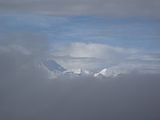
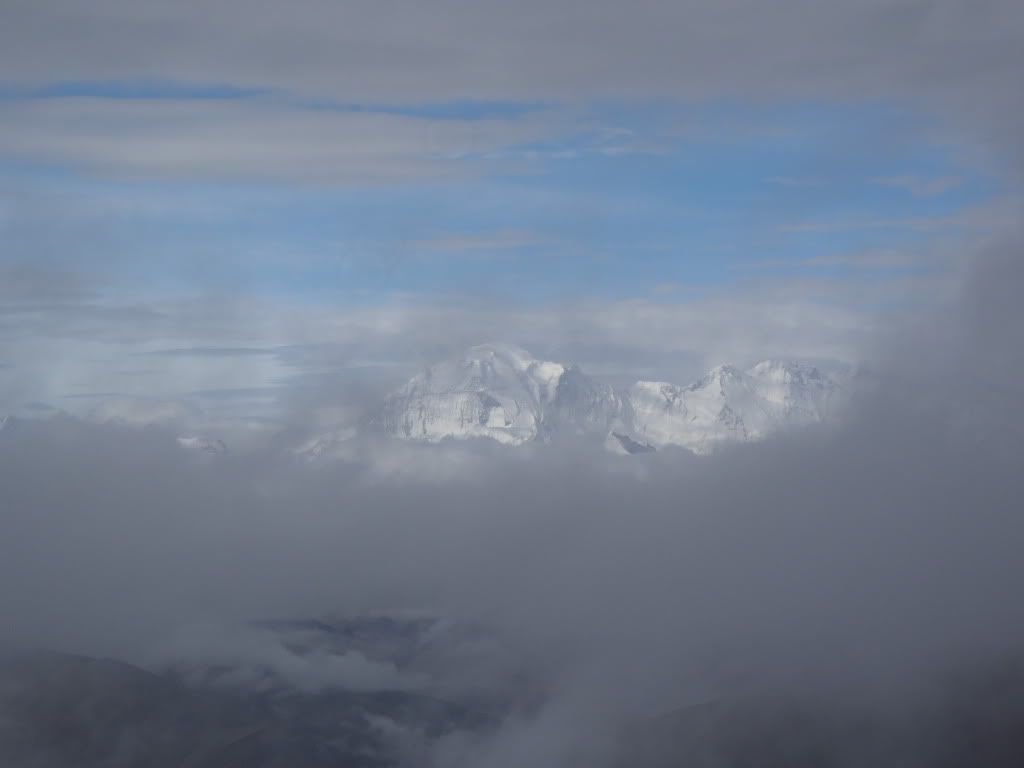
After the platform the road took us downhill, zigzagging its way slowly down the side of the steep mountain. The clouds around Everest cleared once again and we had Monday stop the car for a few more pictures. Of course the drive wouldn’t be complete without Monday attempting to take a shortcut after roughly 30 kilometers of driving. We actually soon had no idea he was following any path at all, but Monday remained confident we’d save time by taking the shortcut. After lots of humps and bumps we seemed to be getting a little closer to the road again and spotted a car in the distance. Unfortunately that car, also a 4WD, was having trouble getting through a riverbed… In fact, it was stuck. We stood around and waited for a while whilst the driver emptied the car of his passengers and finally succeeded to get past the obstacle. We prayed Monday would be as skillful and were happy to see him make it as well. The next problem was getting across the stream. Ray and I made the jump without problems, but the girls were stuck. We stepped a little ways in the water and pulled both of them to safety!

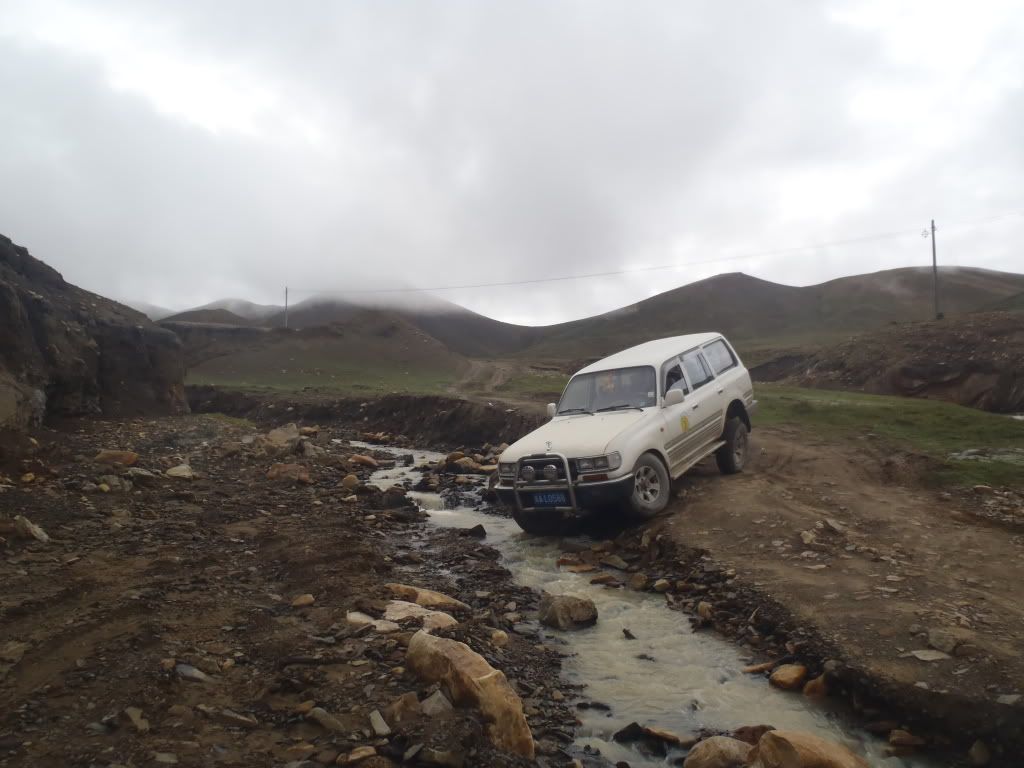
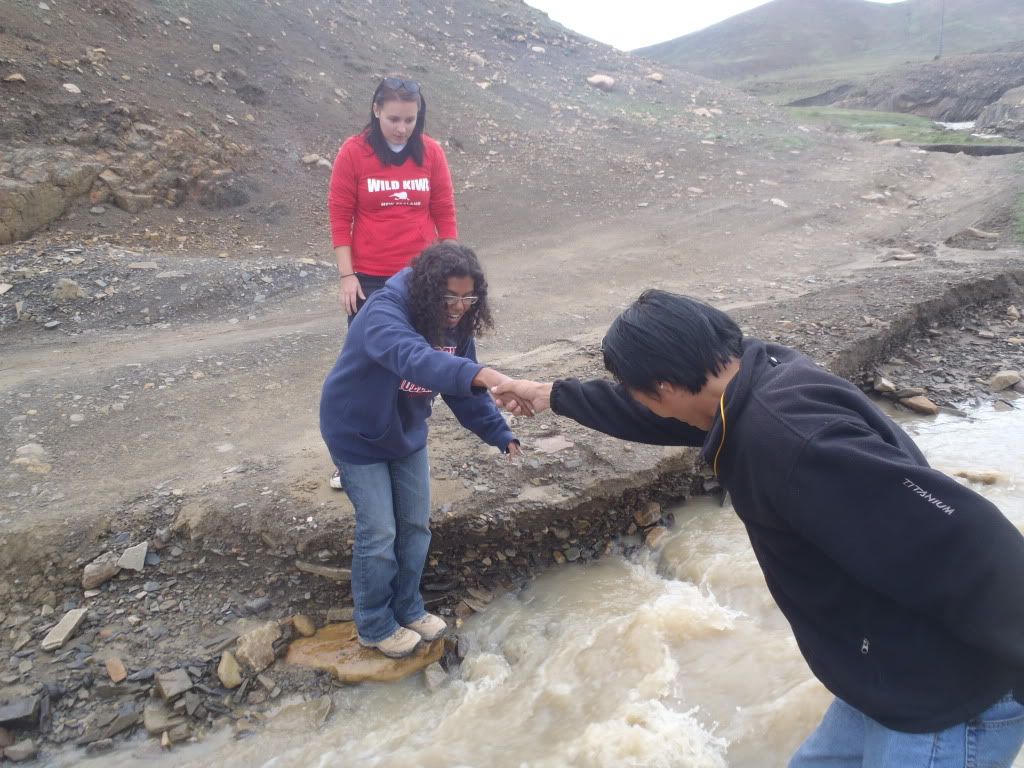
With the road once again in sight our drive to Everest continued. Let me tell you a quick little anecdote about the naming of Everest we’d learned about: the British, who’d laid claims to Nepal when they still held their Raj Empire in India, decided to name the tallest peaks of the Himalayas. They were not quite so obstinate as to discard the locals entirely – a little research was done to see if they’d named the peaks. Of course no name was found, and so Everest was named after one of the more important Brits at the time, George Everest. Funnily enough he never wanted to have the mountain called after him, nor was his name ever pronounced correctly – the world says ‘ever-est’ when it should be ‘eve-rest.’
Onwards again we drove, passing through some small villages (complete with goat-roadblocks) which led us ever closer to Everest. Just before midday its peak showed itself again, this time much, much closer and a lot clearer. We couldn’t believe our luck! We had Ray stop the car and jumped out for more pictures. All the while Ray kept pushing us to make sure we’d get to actually enjoy Base Camp under the same conditions. We, on the other hand, had a hard time listening and had them stop again for even more pictures. Other cars joined us and soon we were part of photo shoot with some other Asian travelers coming from the other direction.
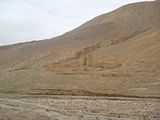
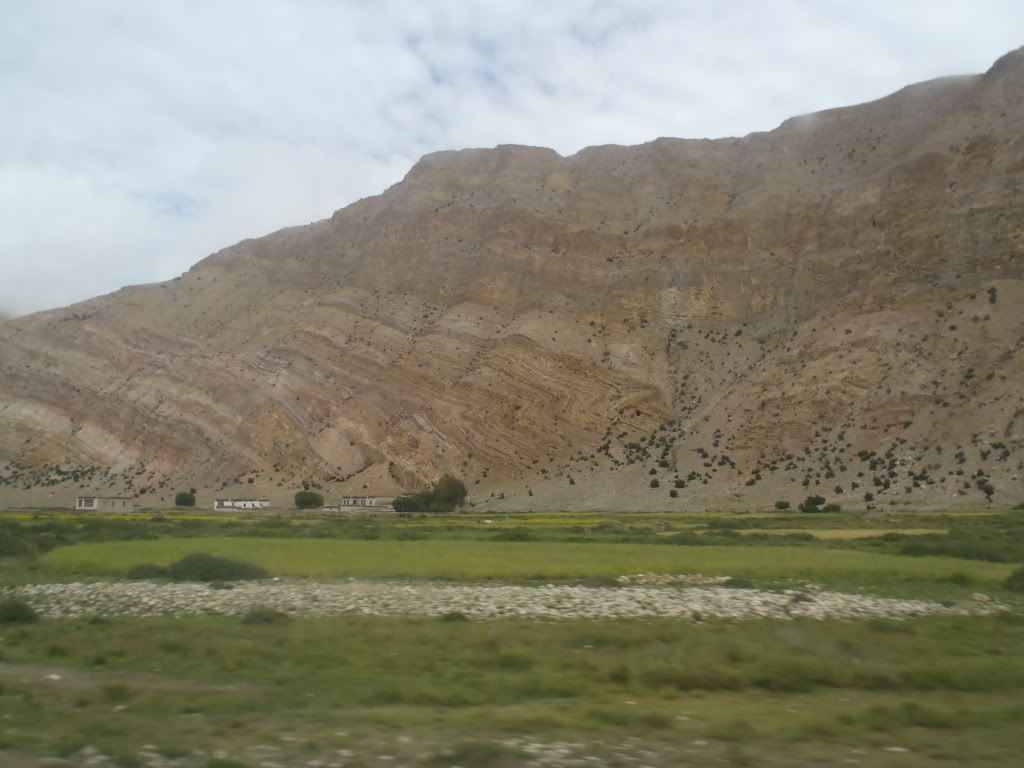
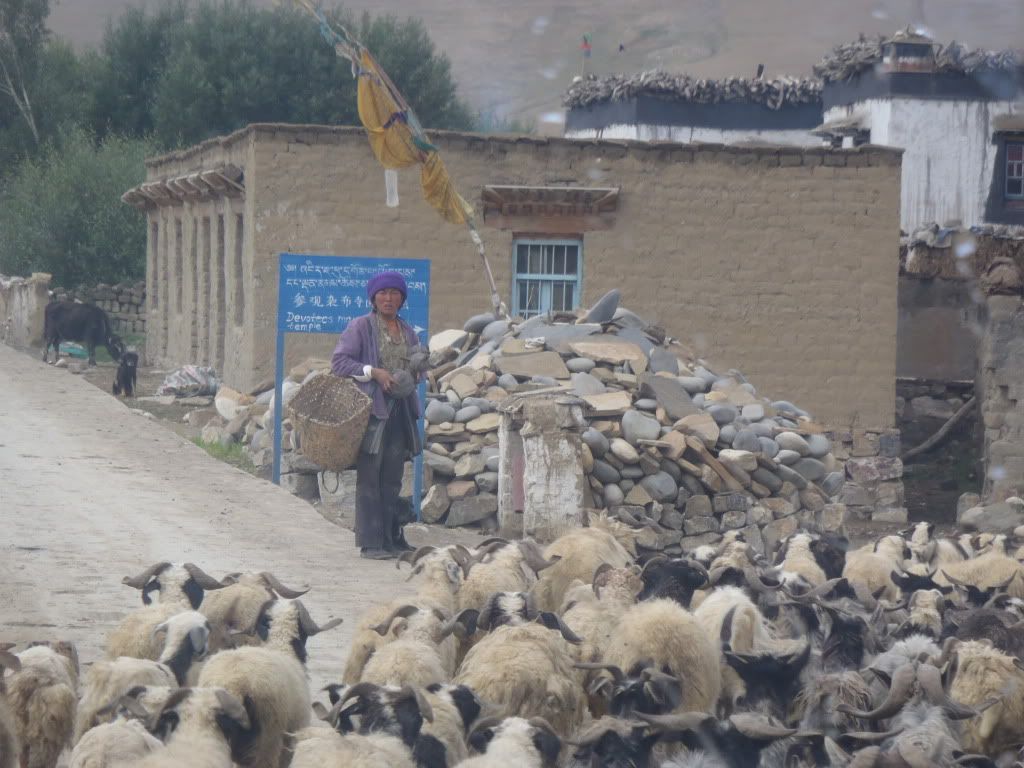
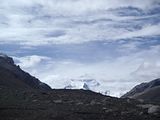

It took a good 15 minutes plus the promise we’d see some rare wildlife to get us back in the car. Wildlife used to be abundant in the region, but hunting by the locals (until the Dalai Lama) and ‘fun’-shootings by Chinese soldiers have decimated populations. Ray said we were pretty lucky to get to see mountain goats and sheep in fairly large numbers. We are actually not entirely sure what they were, so if anyone has a better guess do let us know!
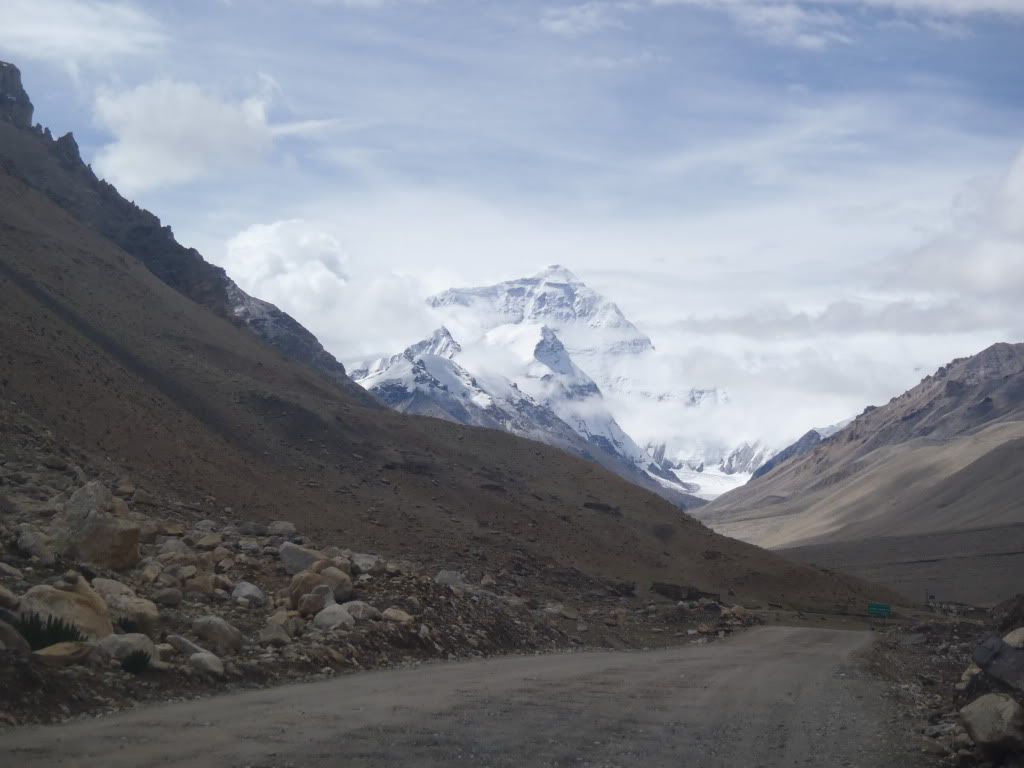
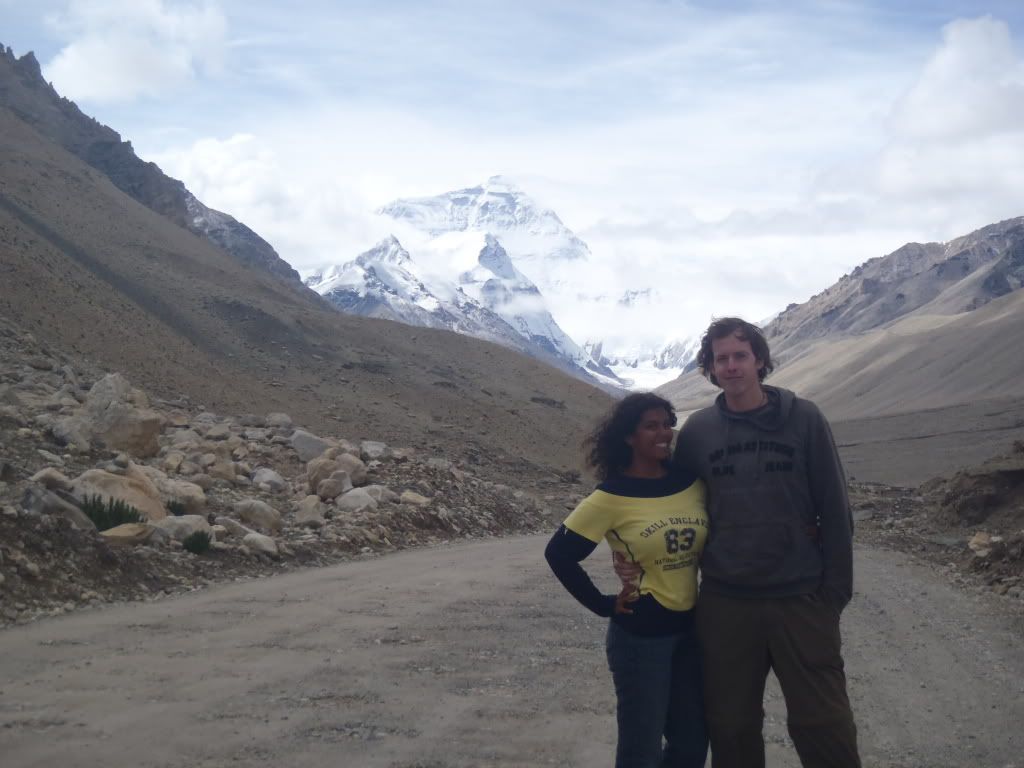
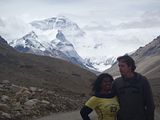
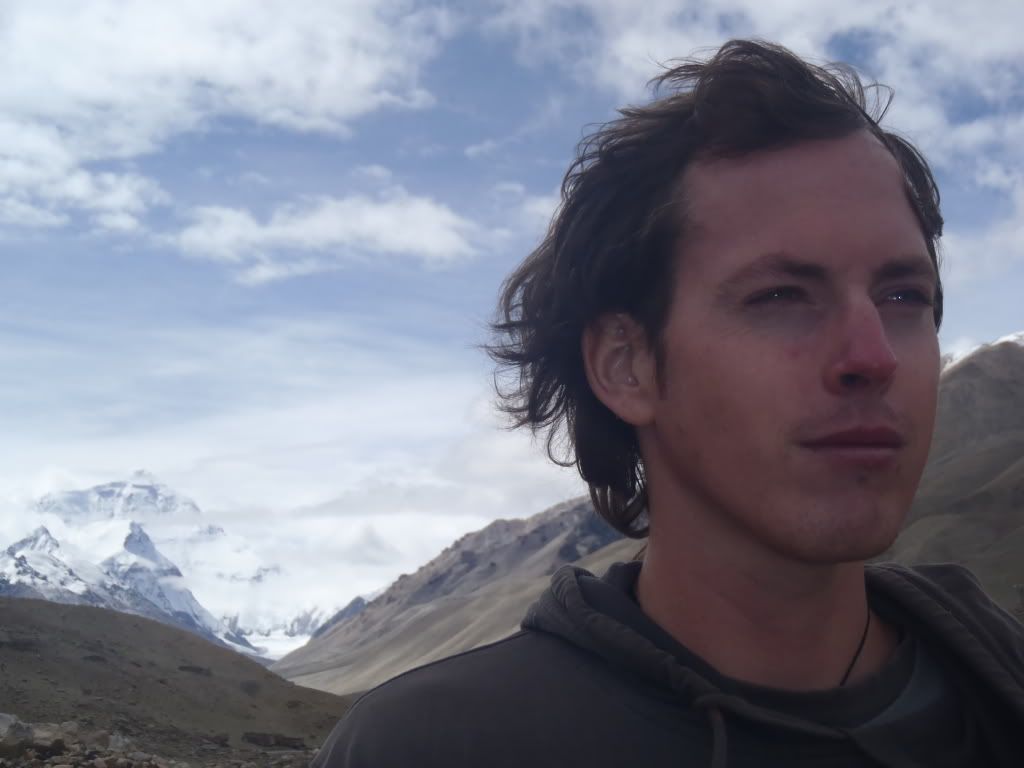
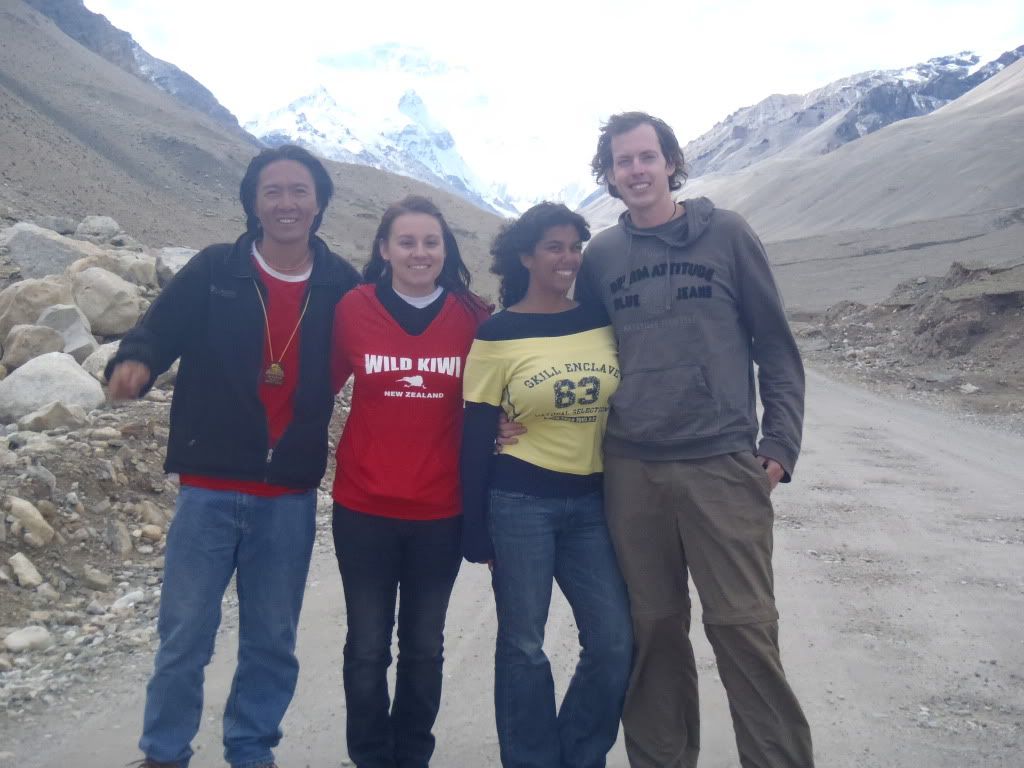
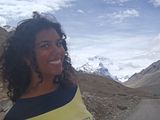
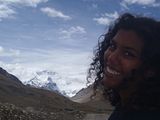
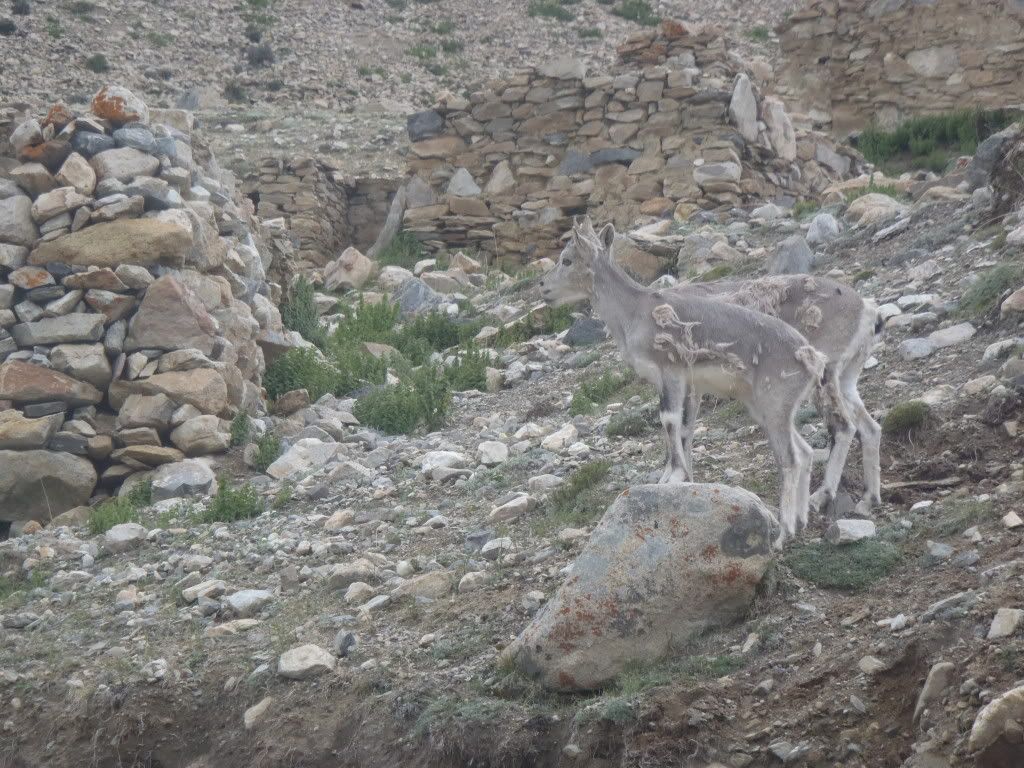
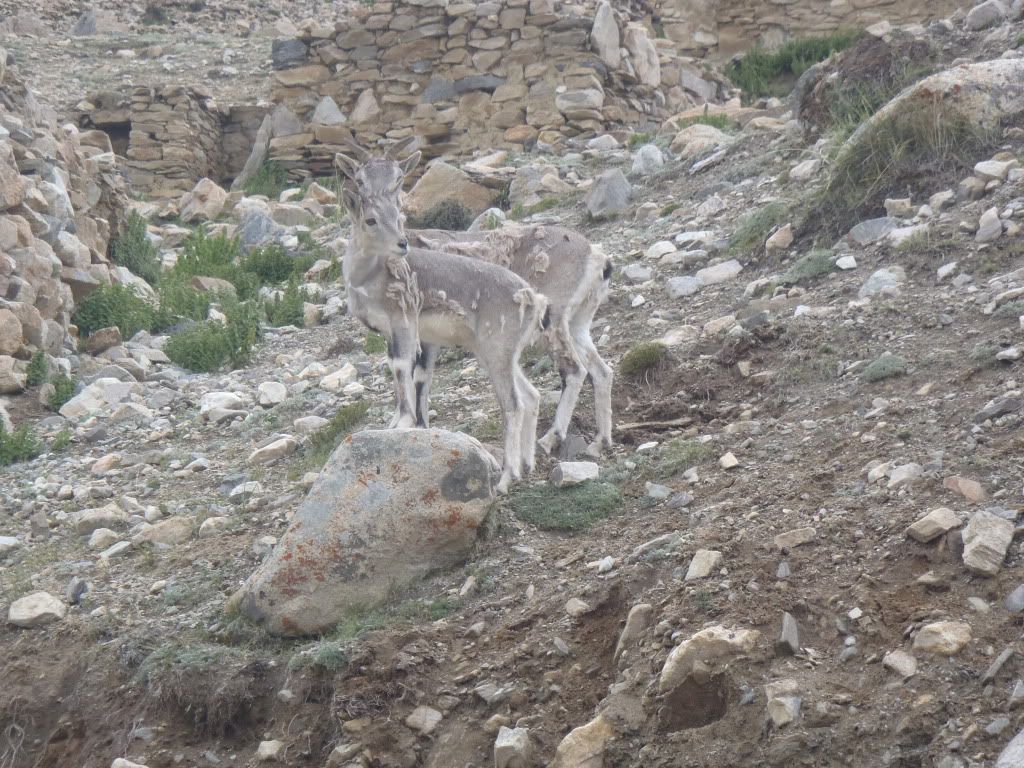
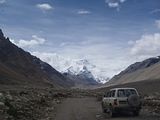
Just around the corner we encountered the actual last monastery of our trip in Tibet. Wiki: “Rongbuk monastery lies by the foot of the Rongbuk Glacier at 5,100 meters (16,700 ft) above sea level, making it the highest religious building, as well as one of the highest-elevation settlements and overall structures ever built and colonized. The Rongbuk Monastery itself was founded in 1902 by a Nyingma Lama in an area of meditation huts that had been in use by monks and hermits for over 400 years.” The Cultural Revolution brought an end to any grandeur Rongbuk once had, seeing part of the monastery destroyed and most of its relics taken away to another monastery. When those treasures were destroyed in a 1989 fire Rongbuk died with it. The smallish building that replaced the old structures is far less grand and reportedly houses no more than 30 monks and nuns.
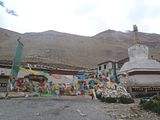
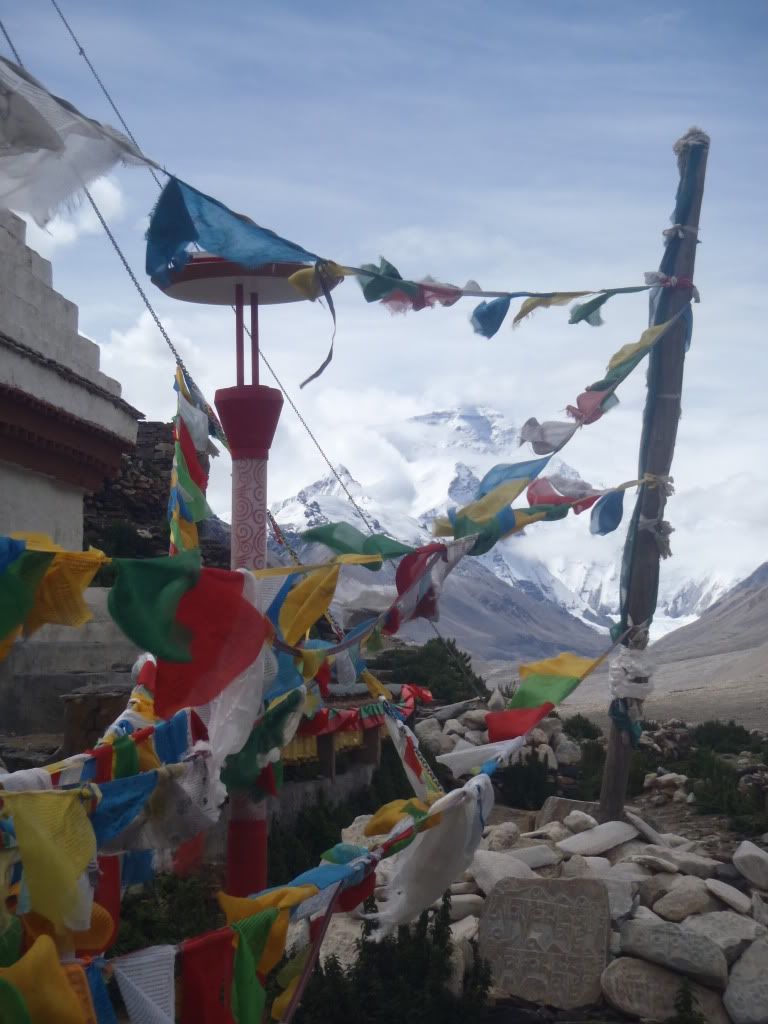
Suddenly, with Everest in full view, we didn’t feel like lingering here, took some quick pictures and had Monday put the pedal to the metal. Whilst driving Francesca hung out of the window, still taking more pictures. We reached Base Camp at 12:30 PM, with the sun shining and Everest free from clouds. Whilst Ray obtained tickets for the ‘eco-bus’ to a viewpoint further up the road, Francesca and I walked around looking at some of the souvenirs for sale there. It must be noted the ‘eco-bus’ isn’t in any way particularly eco-friendly, but just replaces any and all 4WDs that would otherwise make their way to the viewpoint.
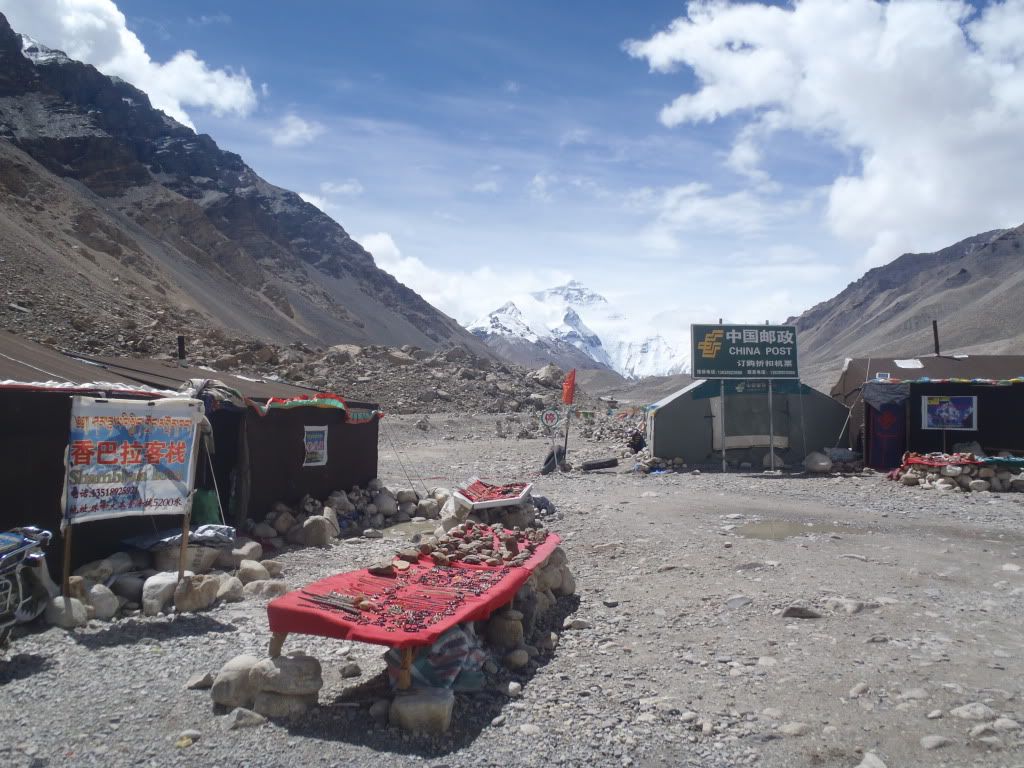
A short drive later we finally arrived at Base Camp Two with Mount Qomolangma right in front of us. Of course those locals had named Mount Everest long before the British ever came near… A sign told us Qomolangma is 8844.43 meters high, but the actual number could be up to 10 meters off. Still, it’s the world’s highest mountain and we were gazing at it! With us already being at an impressive altitude of 5300 meters it may not look like much, but do not forget we were already on the ‘roof of the world!’ I for one was deeply impressed by the mountain and had a hard time leaving it after a long photo shoot to properly capture the mountain.
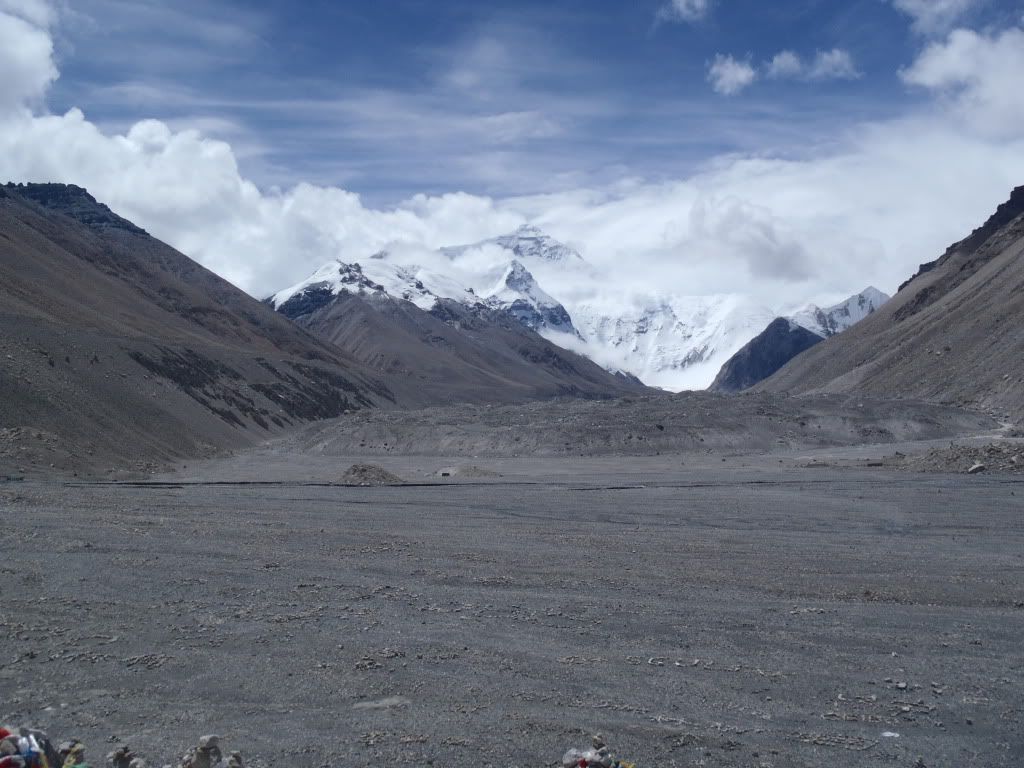
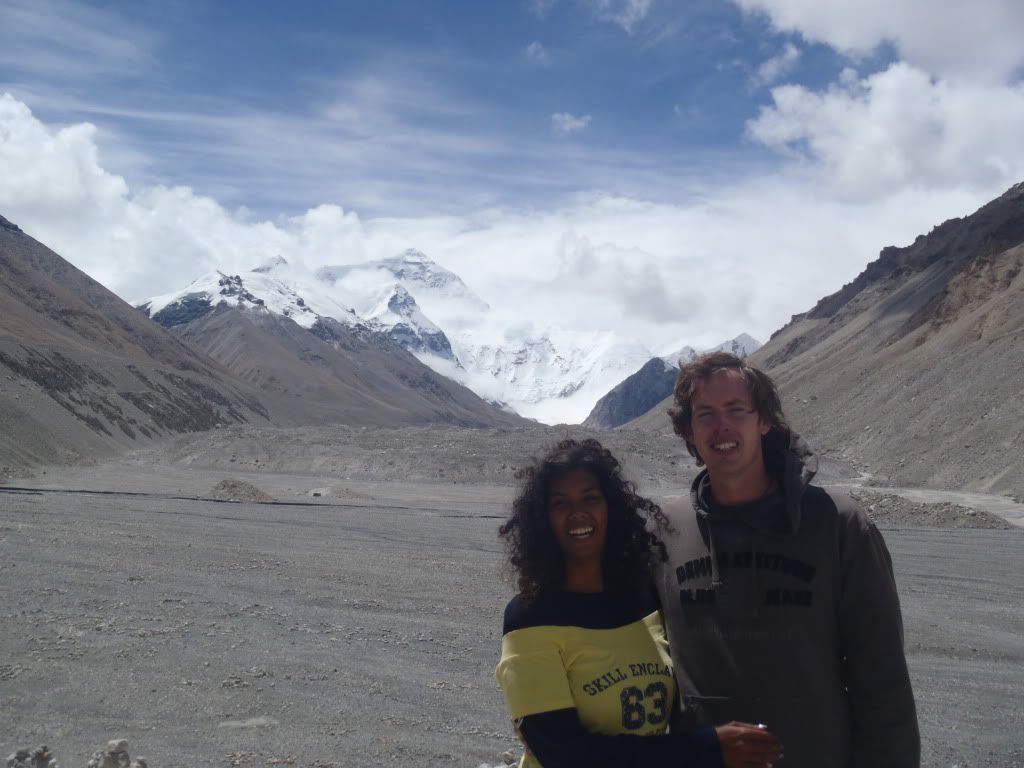
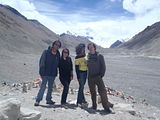
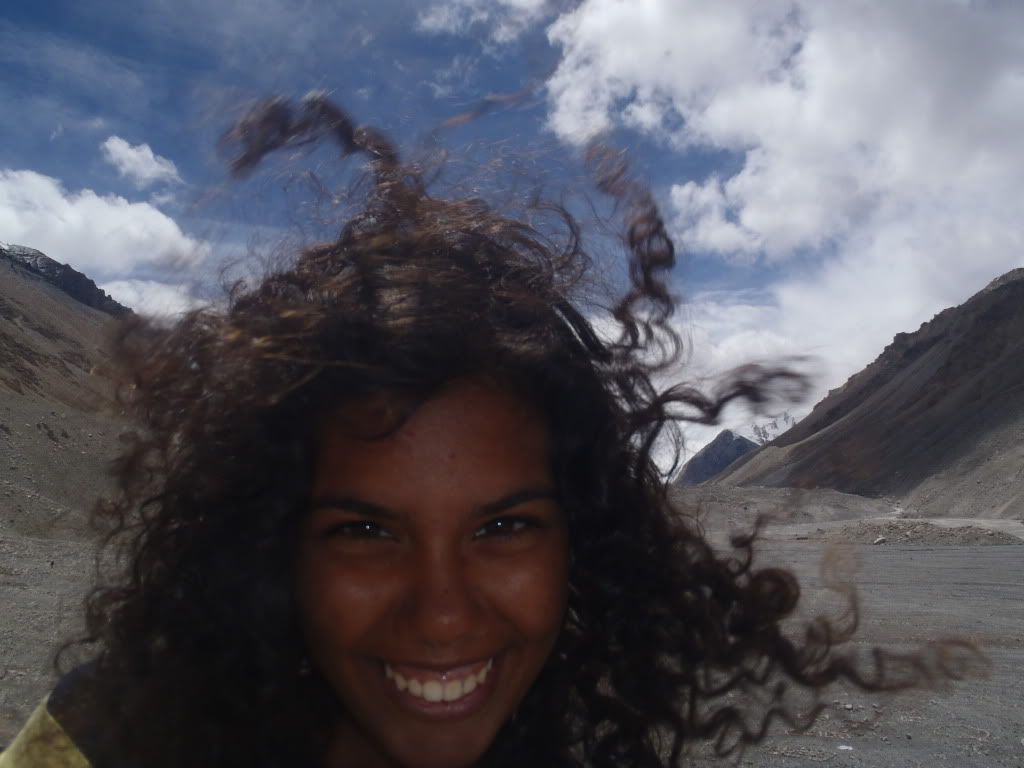
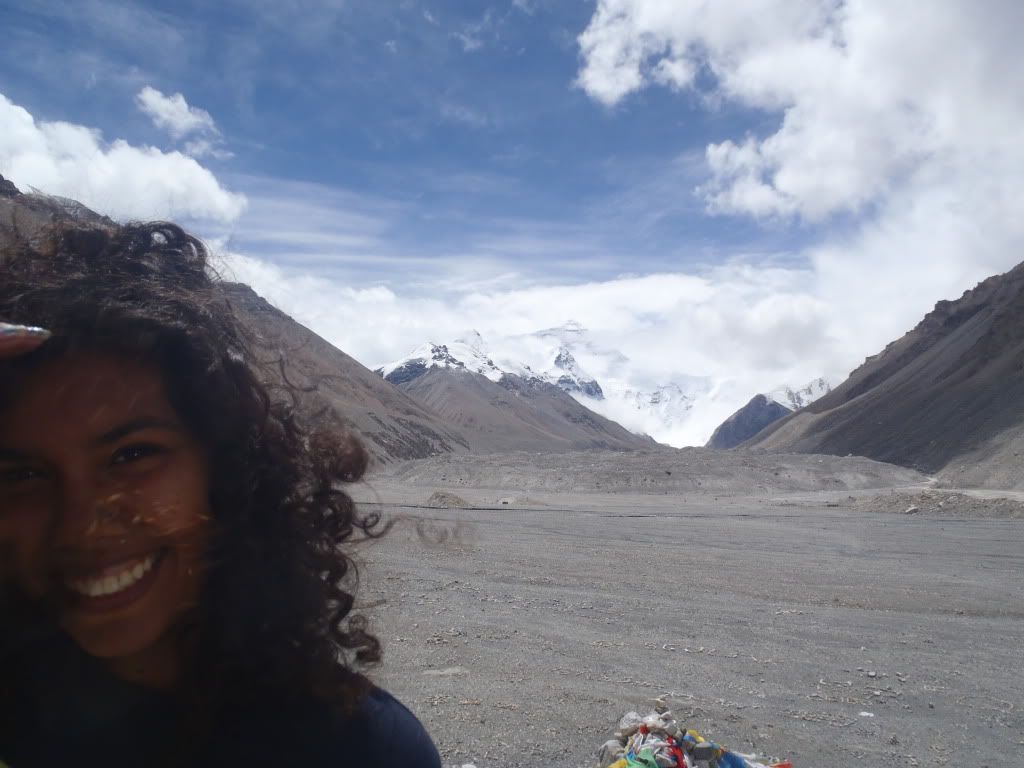
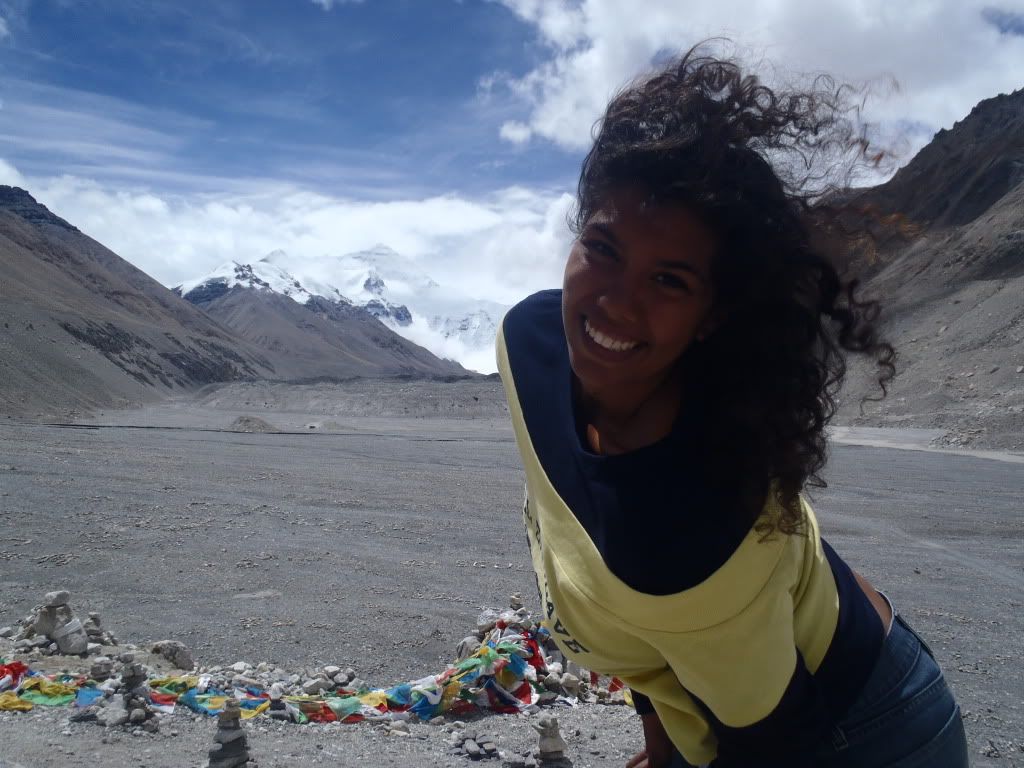
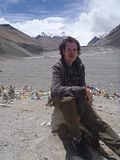
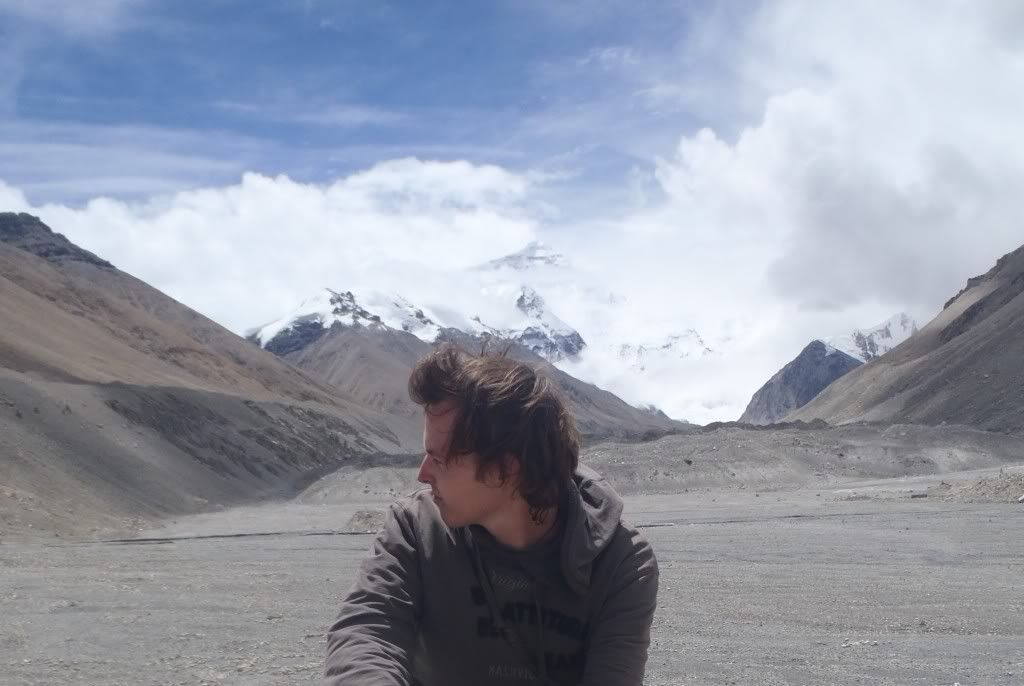
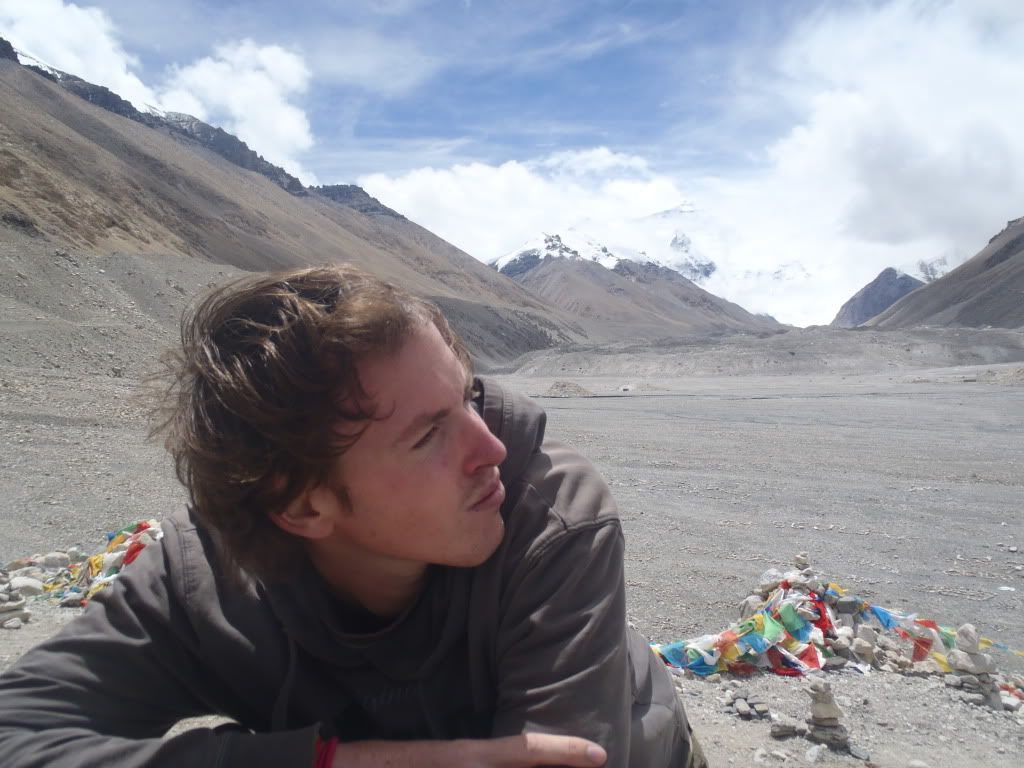

In fact, it took 40 minutes before Francesca and I finally agreed to go back to Base Camp One. I would’ve loved to get even closer to Everest, but Ray told us you need oxygen tanks and a large stack of dollars to be allowed to go there. Back at Camp One we wanted to send some postcards from the highest post office (China Post, sigh…) in the world. Of course the occupying postman wasn’t there and we can only say we would’ve sent our grandparents a card if he’d been there! Whilst we waited for Monday to reappear we had another look at the camp. Francesca was interested in buying a Tibetan amulet, which locals hang around their shoulders for good luck. We consulted Ray to check for authenticity and had him lower the price in the process. We also had a look in the tents (hotels or resorts as some of the locals dared call them) which you can sleep in if you feel like being oxygen-deprived for a night.
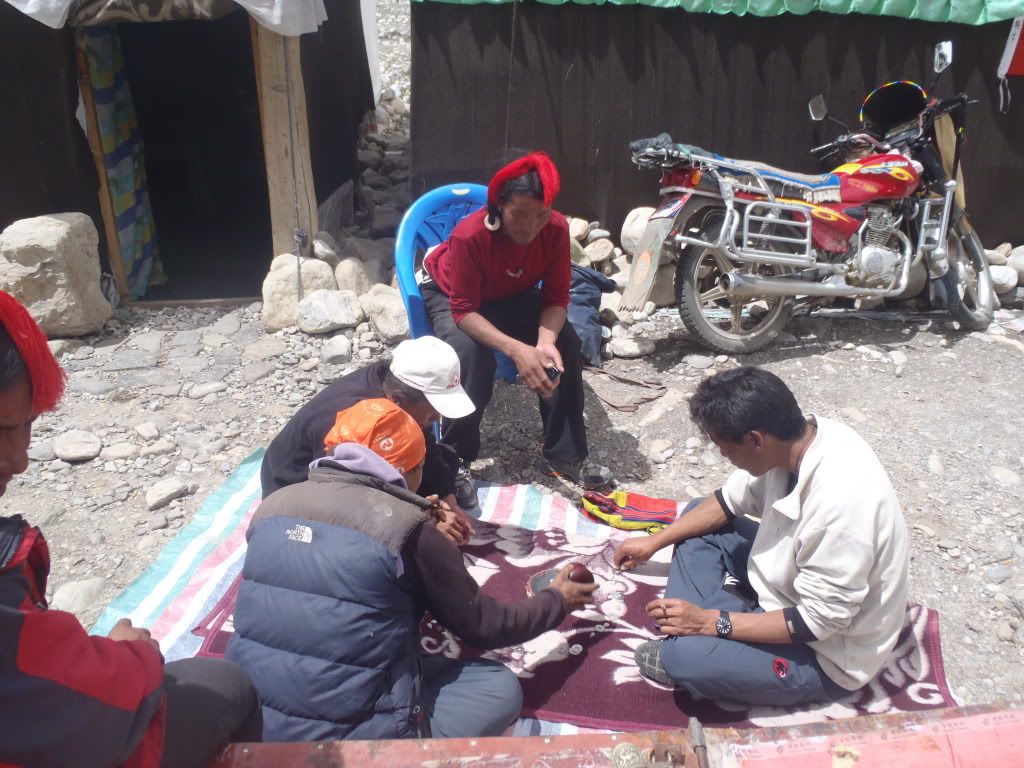
By 2:00 PM we were on the road again. We drove past the mountain goats and sheep that were still camping out near the road. Francesca and I looked behind us one more time to see Everest. Lo and behold! The sky had turned grey and we couldn’t see a thing behind us. Lady Luck must’ve really liked us that day! A good 30 minutes later we had to stop for a road-crossing yak and got out for the final pictures of Tibet’s famous bovines. The grey skies above us had us back in the car in no time though. Soon, the first raindrops were falling on the dust road, turning a tough drive into an even more challenging one. At one point we even had to drive up a stream!
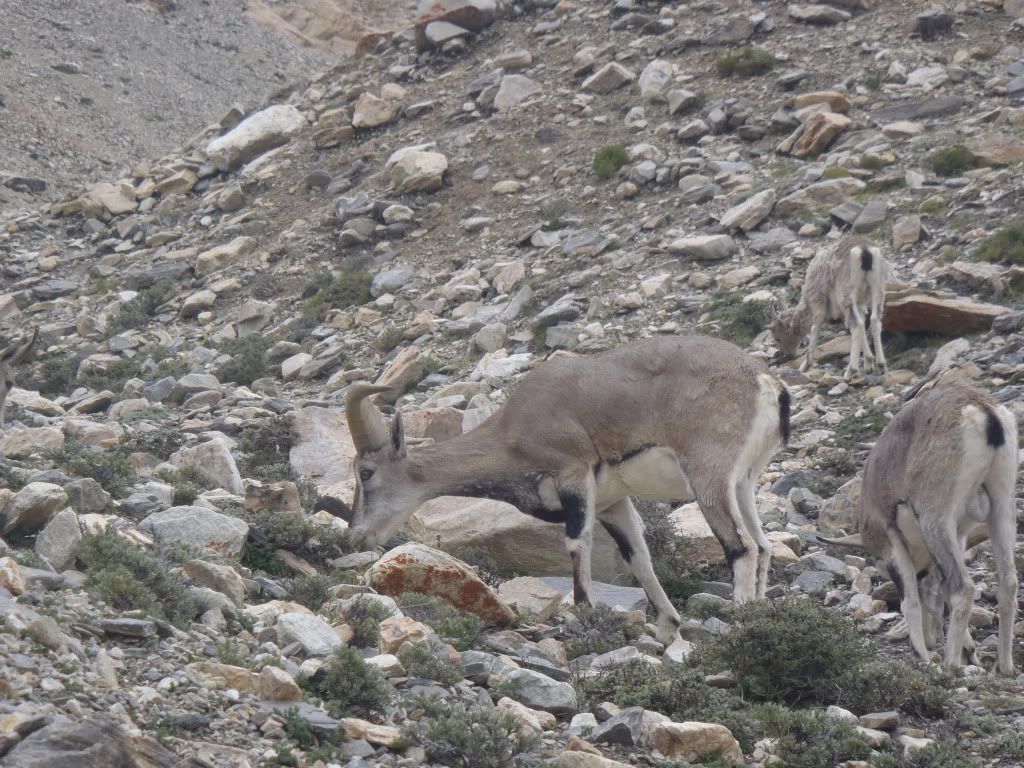
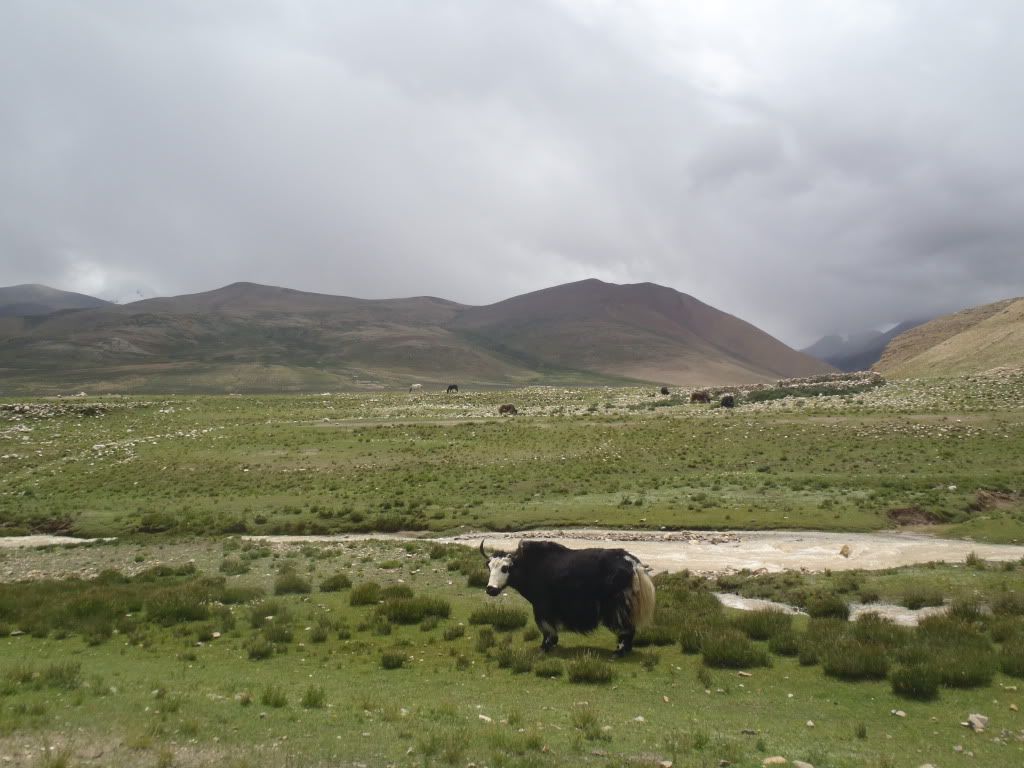
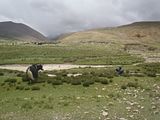
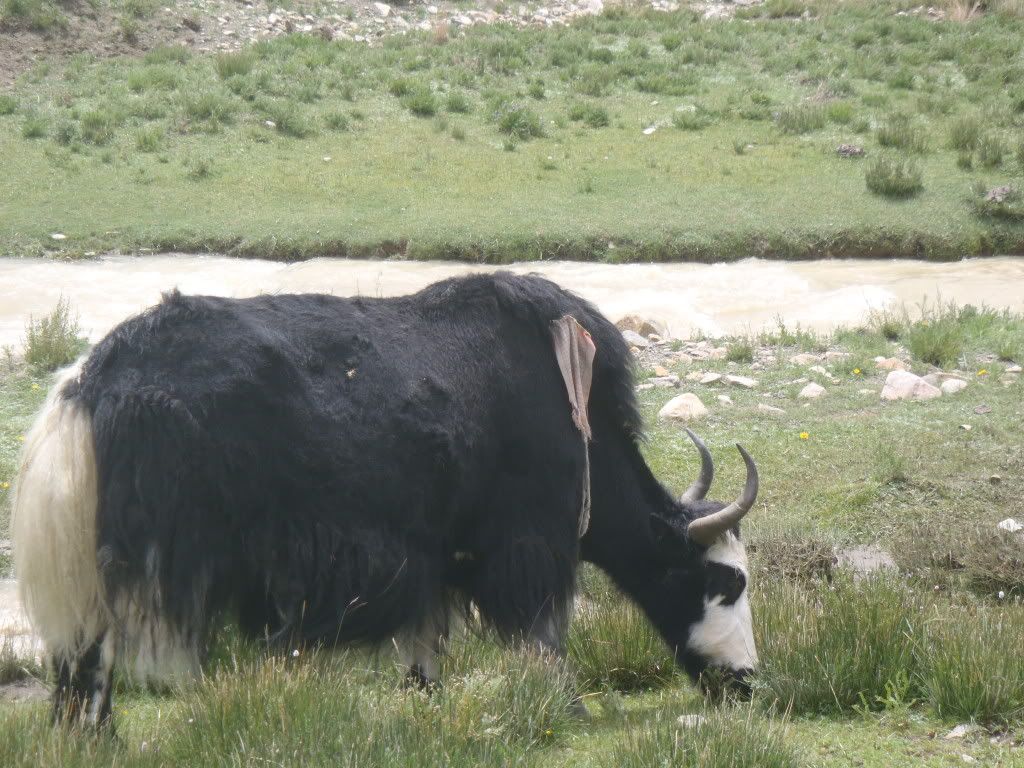
It took roughly three hours to traverse the rough terrain, but finally we were on tarmac again and headed for our penultimate stop on our way to Nepal. Old Tingri was another shitty town with roaming dogs that we could’ve done without. And the first hotel that Ray brought us to was pretty much a hellhole. With Francesca still feeling a little weak I decided we’d better splurge and get ourselves a half-decent hotel. “Snow Leopard Hotel” provided such a service, and even served up a decent dinner in the shape of chicken and potato for Francesca and a noodle soup for me.
That next morning I ordered some pancakes for us, which we ate before the final leg of our trip. The drive to Zhengmu was uneventful, leaving me with little left to say. Just before noon we reached the final pass, Nyalam, at an altitude of 5208 meters. Before us loomed the Himalayas. And it was all downhill from there (literally!). The terrain suddenly changed from a treeless, barren plateau to a lush, green, waterfall-covered valley. Wow, it had been weeks since we’d seen our last trees! Driving to Zhengmu was a real pleasure, partially made possible by the Chinese, who paved the road the year before, making the drive a lot safer and smoother than in previous years.

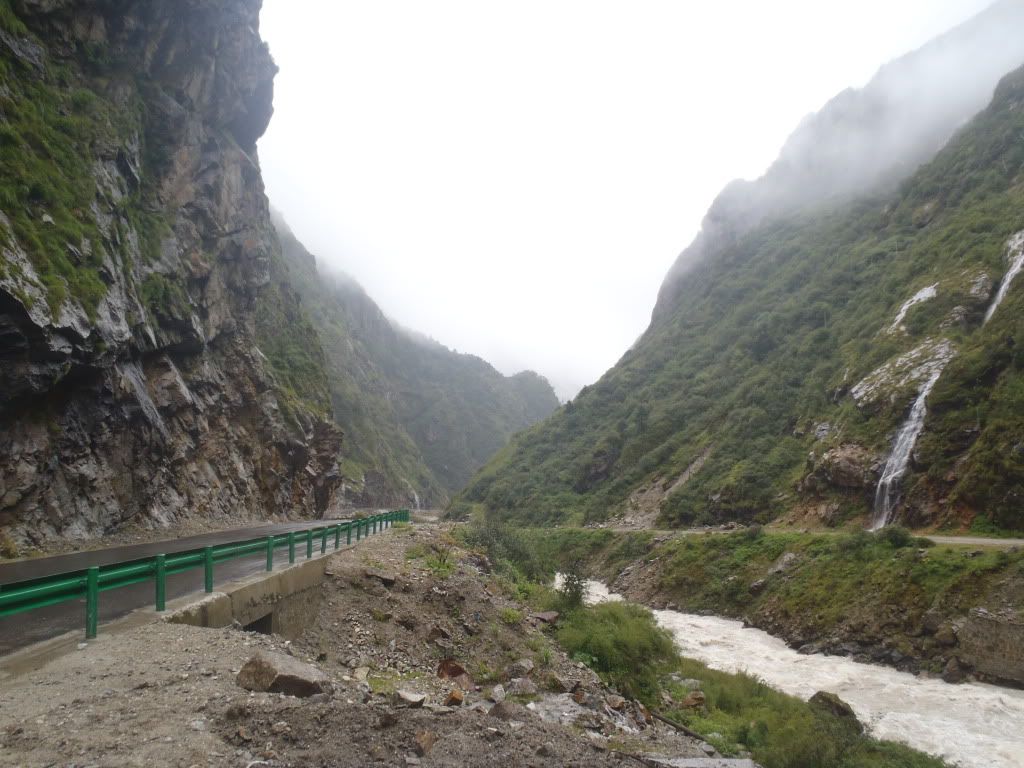
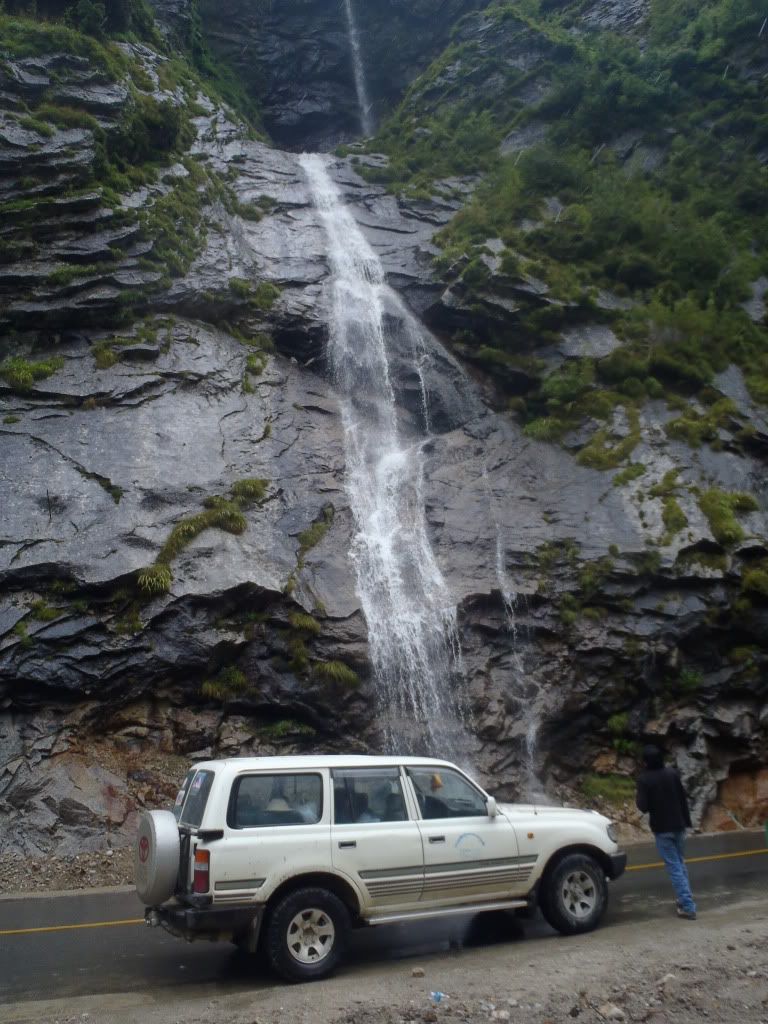
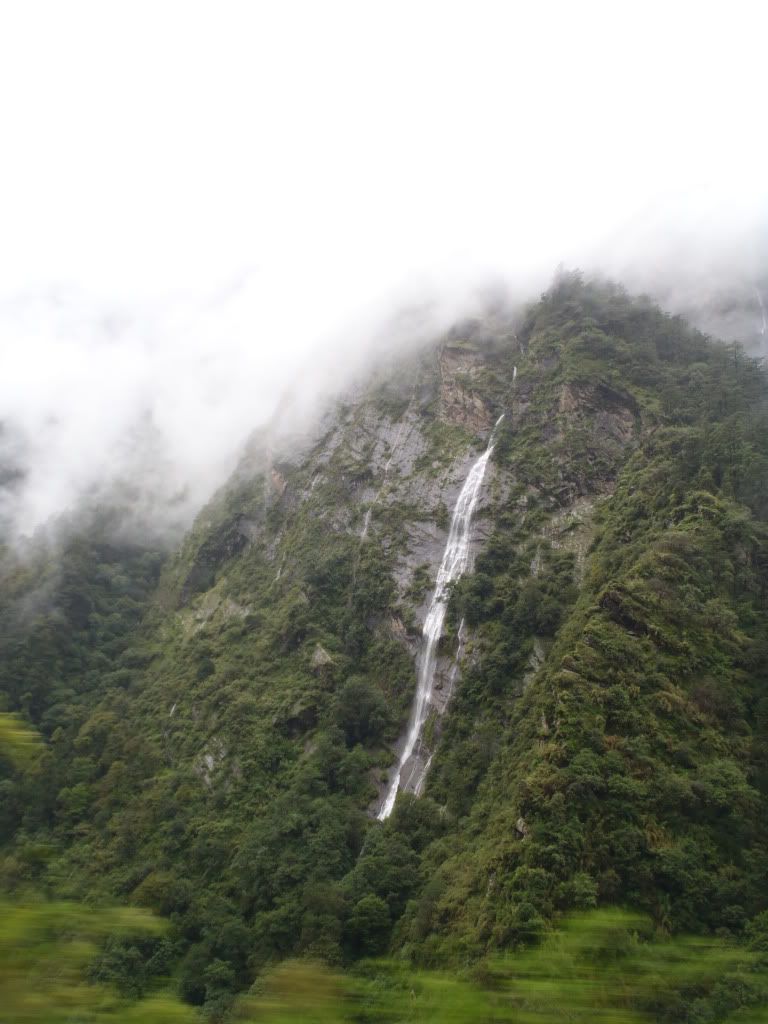
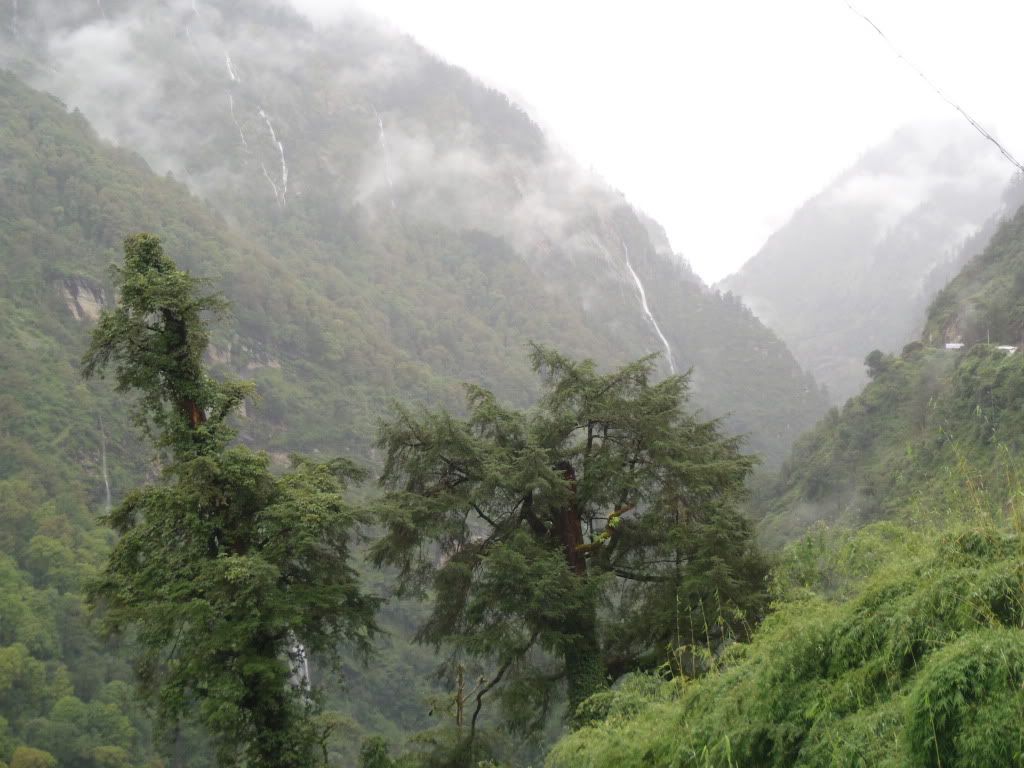
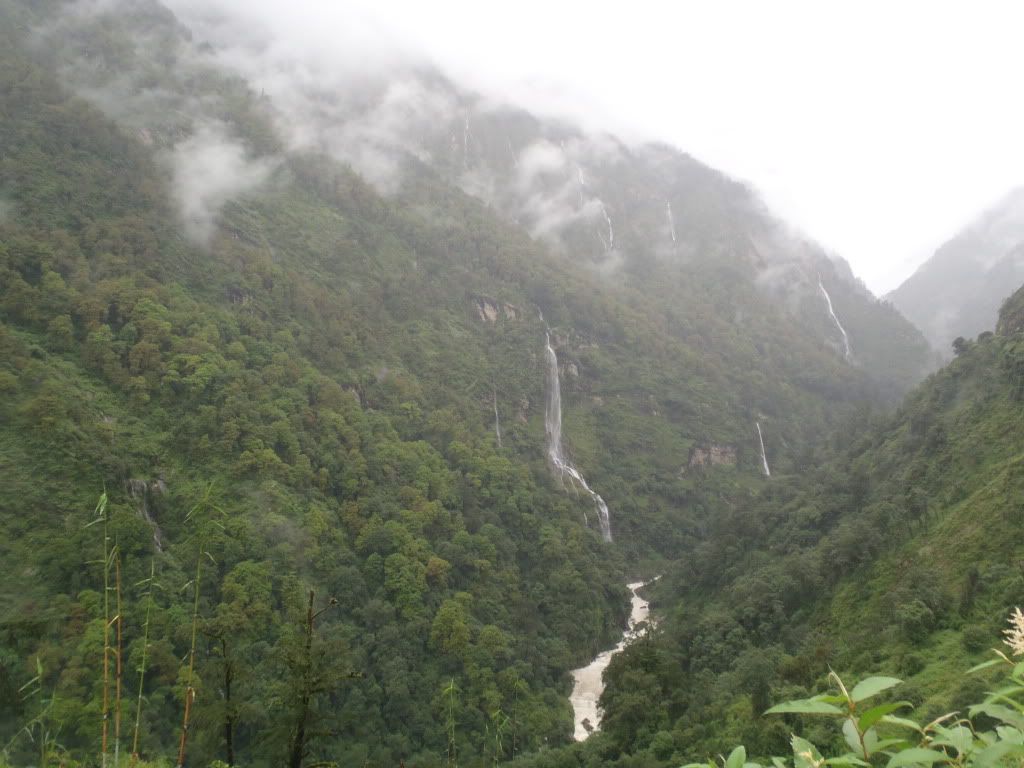
Here and there roadwork was going on (even in the rain), but this didn’t stop us from reaching dreary Zhengmu by 2:00 PM. Ray led us to the Sherpa Hotel, where we got a decent double room including breakfast and with an amazing view for a very reasonable price. Zhengmu is a bit of sad place, being a one street town (albeit long), with high rises on both sides of the street. Most of the street is filled with Nepali and Chinese trucks driving back and forth filling Nepal with cheap Chinese junk. Nothing eventful happened that afternoon. Francesca and I read up on our Kathmandu knowledge for the following day’s border crossing. We headed out for our last supper with Ray and Sam that evening, enjoying a grilled cheese sandwich and chicken curry in the sports bar-like Gang Gyen Restaurant.
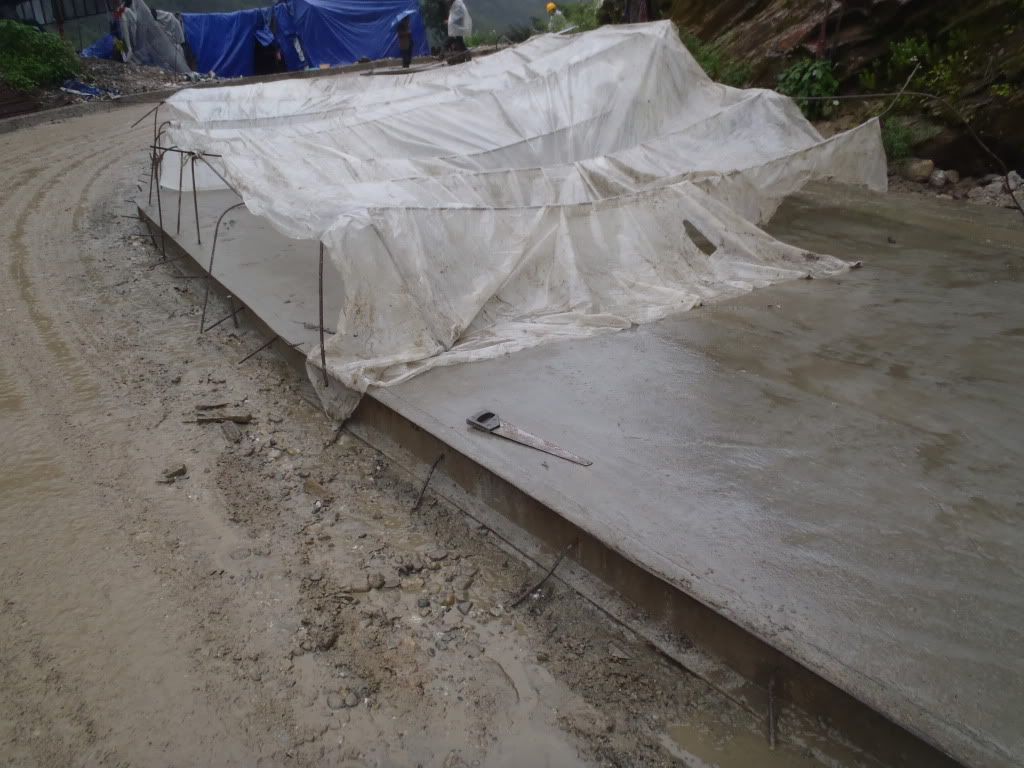
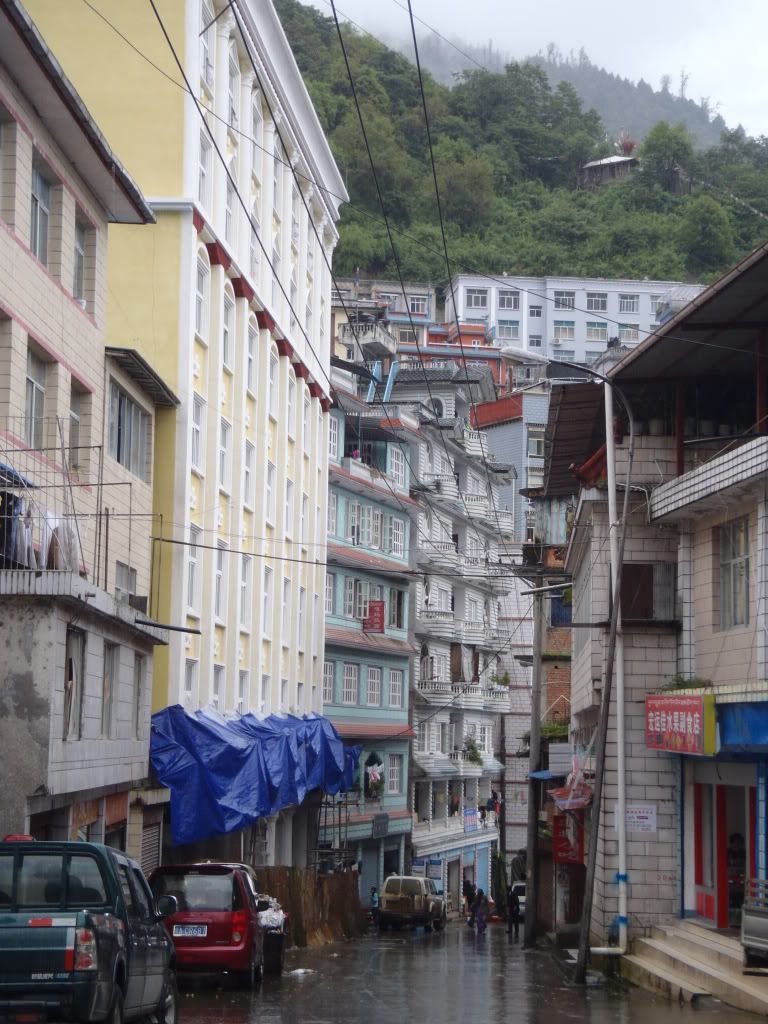



Our travels in Tibet came to an end on the morning of the 25th. We ordered some lunchboxes from the Sherpa Restaurant, hugged Sam and said goodbye to her, drove off to the checkpoint and stood in line for immigration with Ray. He stayed with us until we’d cleared customs and knew where we had to go. Francesca and I said goodbye to him as well, thanking him for the great guide he had been and hoped we’d be able to come back one day. Then we grabbed our backpacks and made for Nepal.
Sunday, August 22, 2010
The Last Monastery
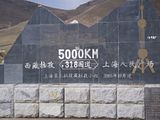
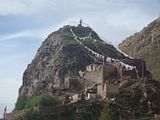
Just past 11:00 AM we reached the highest point of the Tsola Pass, with 4900 meters one of the shorter passes we’d come across in all of Tibet. Still, the view was impressive. About an hour later, just past noon, we arrived in Sakya proper, ready to explore our last real monastery of our trip. Sakya Monastery is the only monastery of the Sakya Sect, and would therefore hopefully be different from our previous experiences.
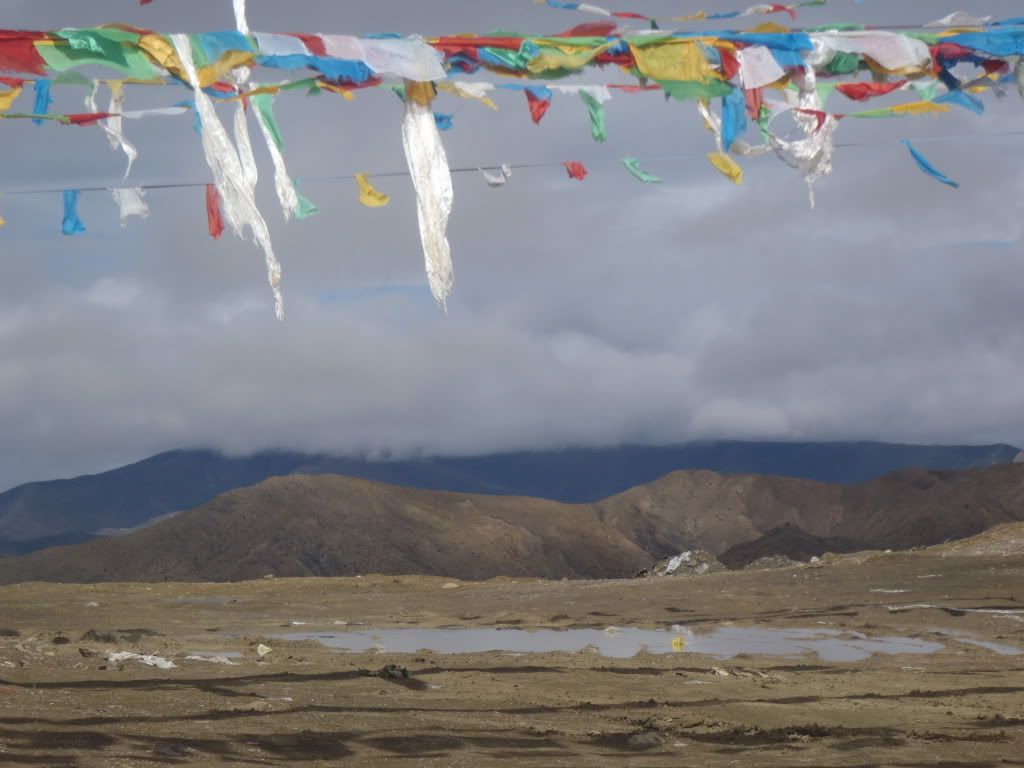
Originally, the Sakya Monastery comprised two buildings. The first was the Northern Monastery. In 1073, Khon Konchog Gyalpo, the founder of Sakyapa Sect, built a white palace on a grey clay hill near the northern bank of the Chun Qu River. The locals named the palace 'Sakya' which means ‘grey soil.’ This was the Northern Monastery, but today it is visible only as a ruin. The second building, the Southern Monastery, was built like a fortress and surrounded by a moat. Construction of the monastery began in 1268 and was commissioned by Choygal Phakpa, the fifth descendent of Sakya Sect. The walls of this monastery were painted in red, white and grey which indicate Manjusri Bodhisattva, Avalokiteshvara and Vajradhara and was the building we’d visit today.
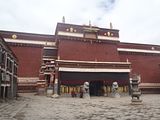
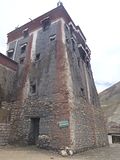
The moat is no longer part of the premises, but the Monastery, as built by Choygal Pakpa still has its colors intact. Our little group walked up to the enormous black walls and entered through the equally impressive gate. We entered a small courtyard where we purchased our entrance tickets and had a look at some enormous (and ugly) Chinese lions. We learned that these lions were gifted to the monastery by Shanghai, but sadly we also heard Tibetans have started copying the tradition of putting lions in front of their doors. Ignoring those abominations the rest of the courtyard simply looked wonderful. Everything had been painted in the colors I mentioned before, with small paintings as extra decorations all over the place as well. And all around us prayer wheels lined the walls.
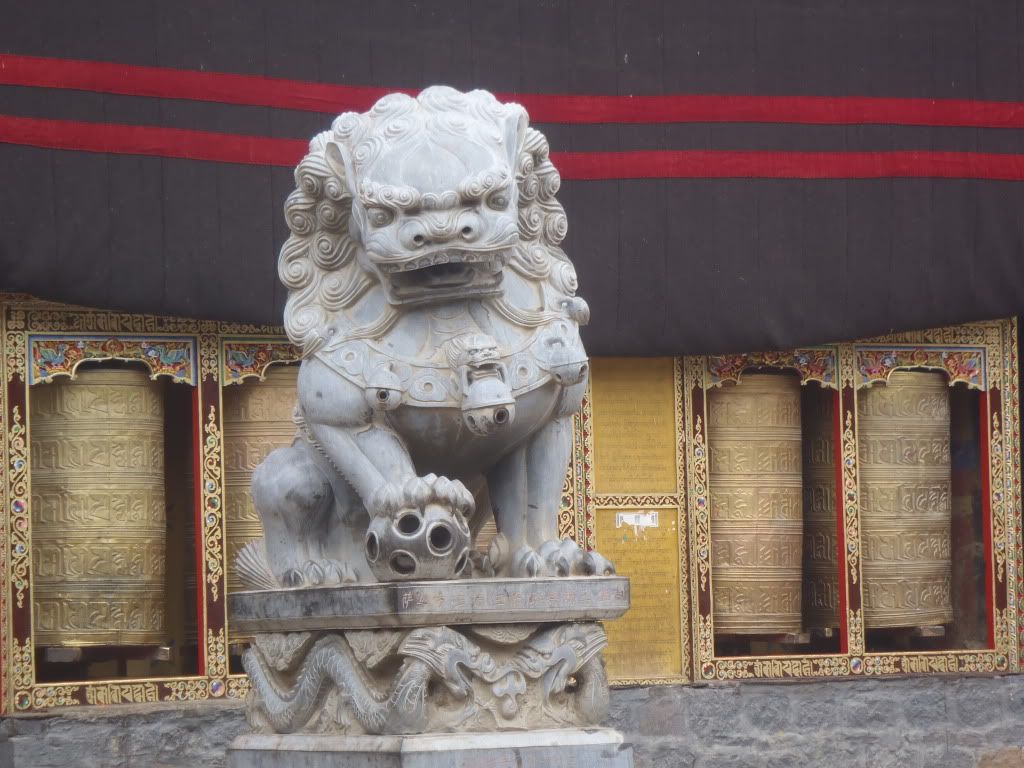
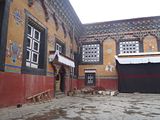
I walked ahead, following Ray through another tunnel, whilst the girls trailed a little behind me. Ray led us into a small hall on the left, where a ceremony was taking place. Trying not to disturb the monks we had a quick look at the statue of Shakyamuni and a somewhat obscured mandala with some foot high statues that looked pretty cool. A little later we entered the ‘Main Chanting Hall,’ also called ‘Lakhang Chenmo’ in Tibetan. What an enormous space! We heard it can hold about 10,000 monks in total. To support such an enormous chapel the pillars were imported from Kashmir in India – the wood apparently only got stronger as the ages passed. Four of the pillars are over 1 meter in diameter and now feel as hard as stone. In the hall we spotted three enshrined Buddhas – Dipamkarara, Sakyamuni and Maitreya, and five Sakyapa ancestors.
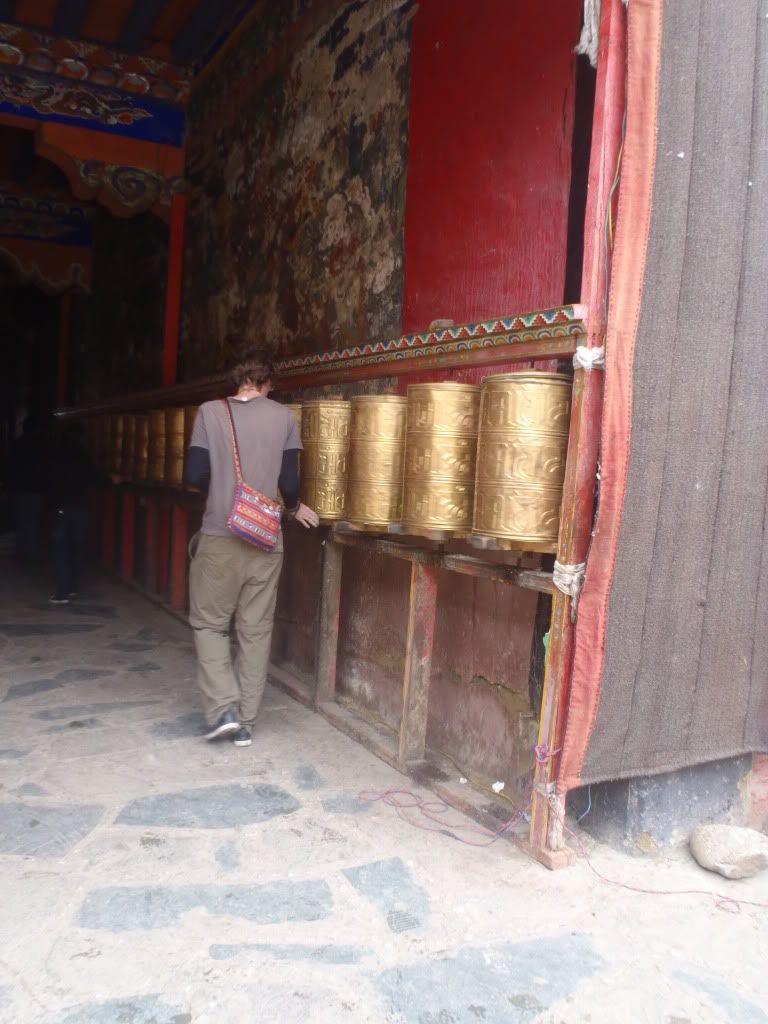
Ray then led us to the southwestern corner of the hall, where we had to pay a little extra to see the most impressive hall of the entire monastery. As we entered the library an enormous wall of books dawned in front of us. Apparently the collection here is second-largest in all of Tibet. It is rumored over 40,000 volumes of scriptures – both Shakyamuni’s teachings and commentaries by other monks – are kept here. The whole wall is “about 57 meters (187 feet) long, 11 meters high (36 feet) and one meter wide (three feet) and has 464 grids. Among them, the most precious is Burde Gyaimalung, which records Tibetan religion, history, philosophy, literature, agriculture and animal husbandry. It is 1.8 meters (six feet) long, 1.3 meters (four feet) wide and 0.67 meter (two feet) thick and boasts the biggest scriptures in the world. Additionally, it also houses 21 volumes of Buddhist scriptures written on Pattra leaves in Sanskrit. Each consists of one hundred to two hundred pages and four-color illustrations. They are the most precious sutras in the world.” Thank you travelchinaguide.com. Legend has it that even if the monastery were to crumble the library would stay intact.
Thoroughly impressed we headed back outside and climbed a steep staircase to the second floor. Several smaller halls are home to murals of mandalas, the best preserved in the monastery. Other murals depict Guru Rinpoche and his manifestations, still preserved with their original paint. After going back down the stairs there was one hall left to visit: the Shrine of Choygal Pakpa. We passed a door with the remains of some wolves above the door, put there by protectors of the monastery. Creepy! The Shrine used to be Pakpa’s living quarters, but was sadly partially destroyed during the Cultural Revolution. The monks are still collecting money to have the place restored… We had a quick look inside, but had to agree with them: the place does indeed need some renovation.
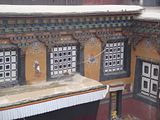
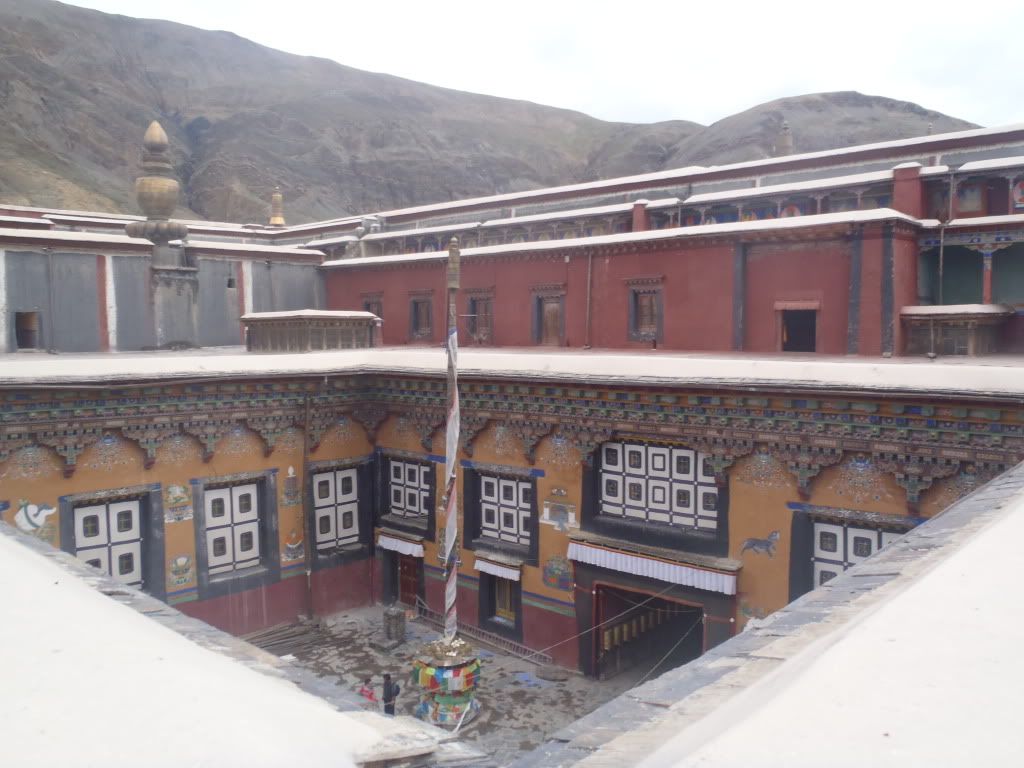
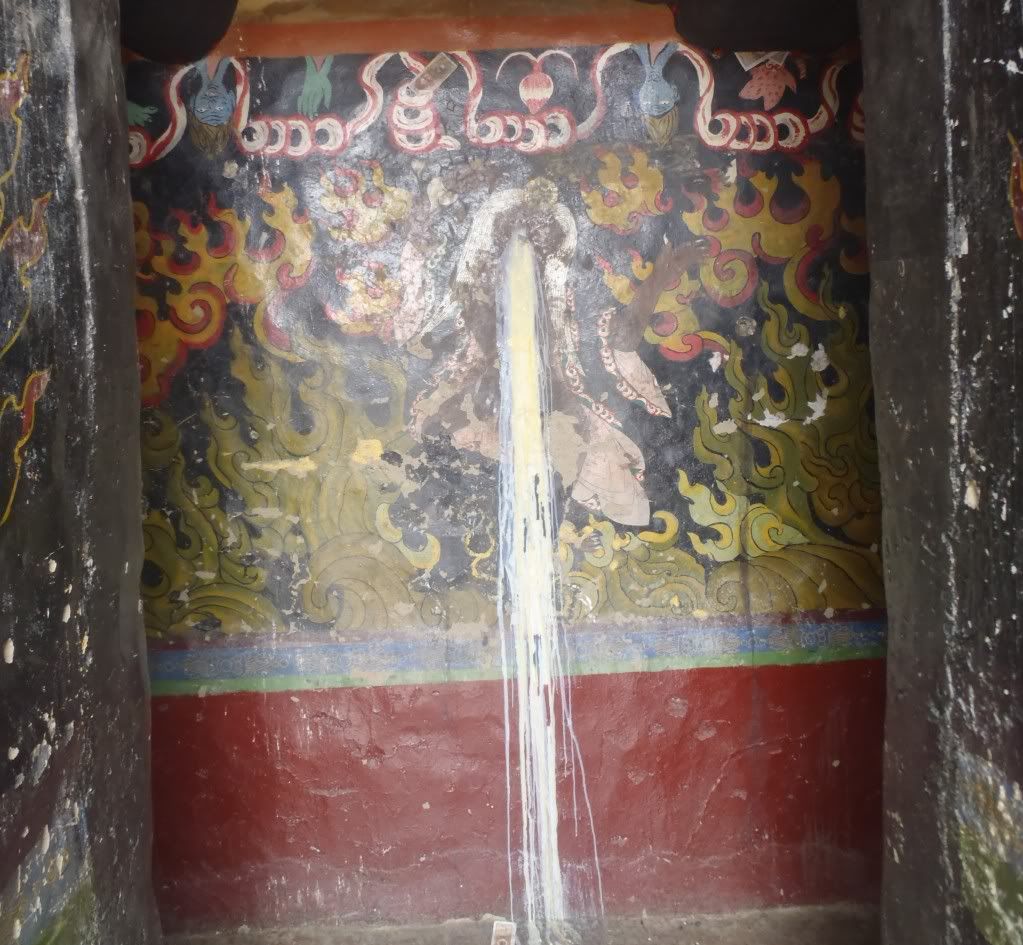


Lunchtime had come for us as we were all a little hungry. Ray led us to a large factory of a restaurant called “Manarasovar Restaurant.” Francesca and I ordered a chicken noodle and a cream of tomato soup with some naans to still our appetite. Francesca’s tomato soup arrived after a long wait and tasted pretty bad. She decided to order a butter chicken to fill her up, which was also what Sam did. After 45 minutes of waiting the food still hadn’t arrived and we had more driving to do. Ray walked into the kitchen a few times, after which the meals finally came. The girls were not impressed by the meager amount of chicken and average curry.
Dissatisfied with the poor food we had to get on the road again. Everest Base Camp was coming closer and we could get within viewing distance if we’d keep driving that day. So, onwards we went, passing old ruins of even older, abandoned towns, all the while listening to Sam’s music. Just after 4:00 PM we reached the highest point we’d reach with the 4WD of our entire trip: Gyatsola Pass. With an impressive altitude of 5240 meters a pretty impressive place to get out of the car and take a few pictures. But, even better, there was some snow lying around here! I got to make up for missing the snow in the Netherlands earlier this year and had a snowball fight with Sam, some Italians and a few local kids. Francesca’s stomach had started complaining a bit after the butter chicken and had her stay in the car.
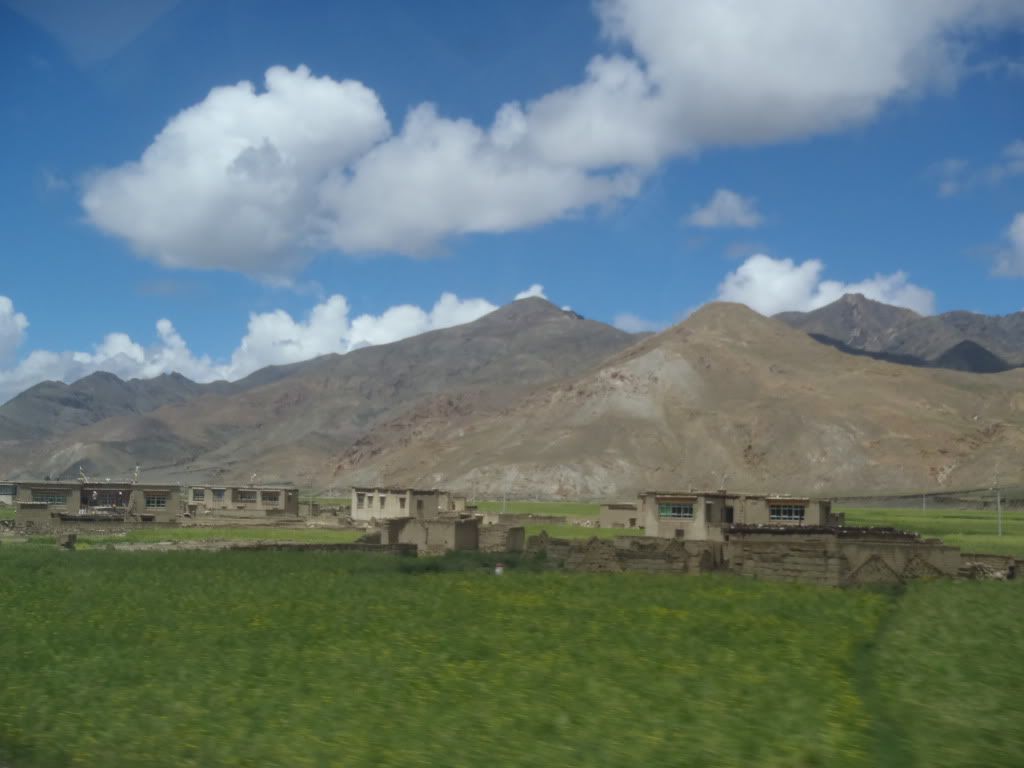
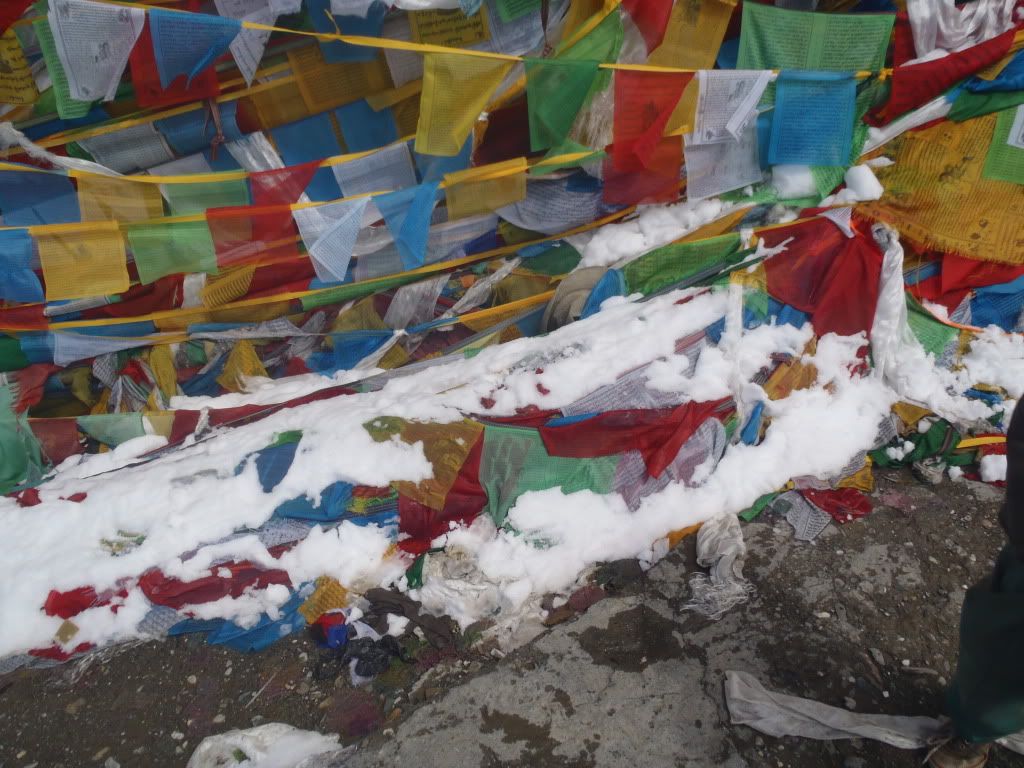
Just five minutes later she did have to get out of the car though: the Himalayas had appeared in our view and it was time to take a few pictures. On our way to Shegar and Mount Everest behind us the eternal snow appeared all around us. Seeing those snow topped cones really started working on our imagination and we were all getting extremely excited to see Everest. Ray warned us not to get our hopes up too much, because it wasn’t really the season to view Everest and it might very well be cloudy… Furthermore, we’d met some other travelers in Shigatse that had already gone to Everest, spent several hours at Base Camp and hadn’t gotten more than 5 minutes of clear view. Ah, I just realized Francesca already told you about that. Oh well, it’s good to refresh your memory anyway!

Around 5:00 PM Ray had Monday stop by the side of the road. We were unsure what was going on, until a nomad came up to the car and showed us a collection of ancient fossils (the forefathers of the modern day nautilus) which are apparently plentiful in the Everest-region. Francesca really wanted to buy a big one, but we couldn’t really carry around the enormous rock it came in. So we settled for a smaller, but more intact one that cost us no more than 10 Yuan ($1.5). We figured there’d be pretty good business buying these things off these guys and selling them back at home. Maybe next time we’ll bring an empty backpack with us!
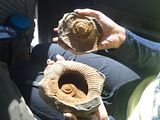
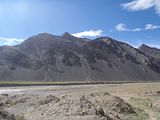
Another 30 minutes later we arrived in Shegar, our stop for the night. Ray led us to the aptly named Shegar Hotel, where the rooms were – hmm, how shall I say this – basic. Our double room was somewhat decent, but Sam’s dorm (which she had to herself) had a door that wouldn’t close and mattresses and beds all over the place. I won’t even say a thing about the ‘toilet’ facilities present. Sam and I had a look around in Shegar and found the town to be as bad as the hotel. The following picture shows pretty much all of Shegar. What an eye-sore. The only thing that is missing is the droves of dogs roaming the streets. We started fearing their incessant barking long before the night started…
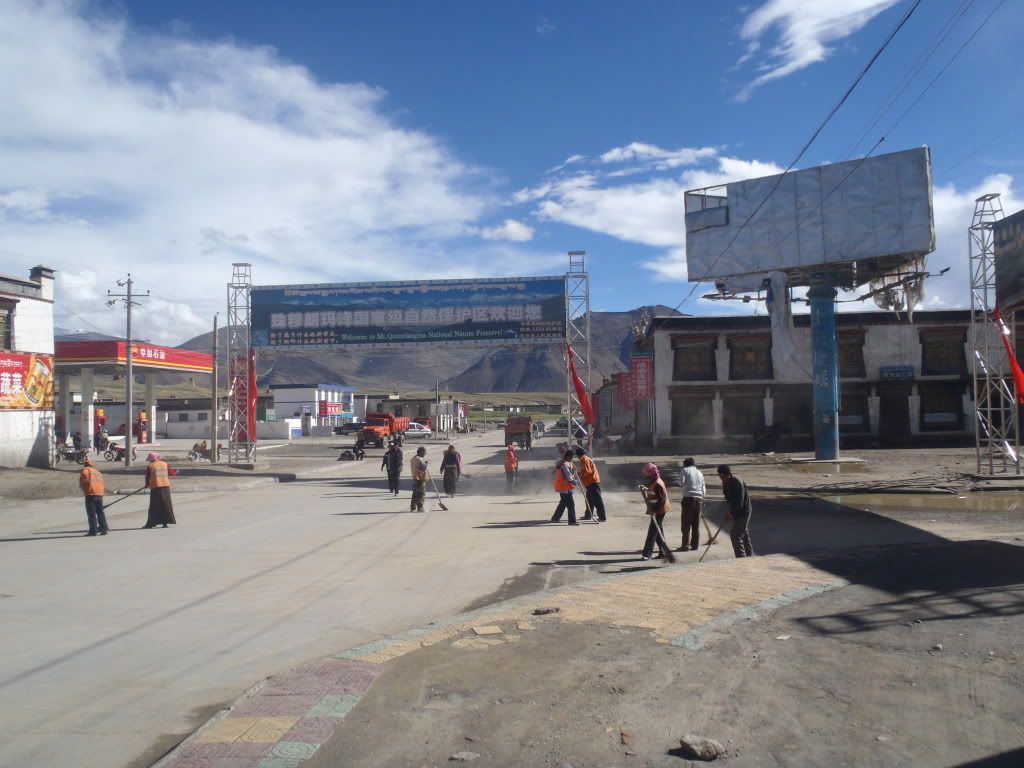
I sat down with Ray and Sam to purchase our Everest Base Camp tickets for the day after. Boy, they’ve got a real moneymaker on their hands there… A good$ 100 lighter we were set for our encounter with Everest. I pulled Francesca out of our room and we headed for dinner across the street. The “Tashi Restaurant” was actually brand new and managed to provide a pretty decent butter chicken and sweet and sour chicken, which Francesca and I shared. After our chow we all headed to our miserable beds and tried to get sleep. Between the loud Chinese people that came in yelling in the middle of the nights (a good whack on the thin walls and some shouting on my part shut them up!), the dogs, and the passing trucks our shut-eye that night wasn’t too write home about (I’m doing it anyway!).
